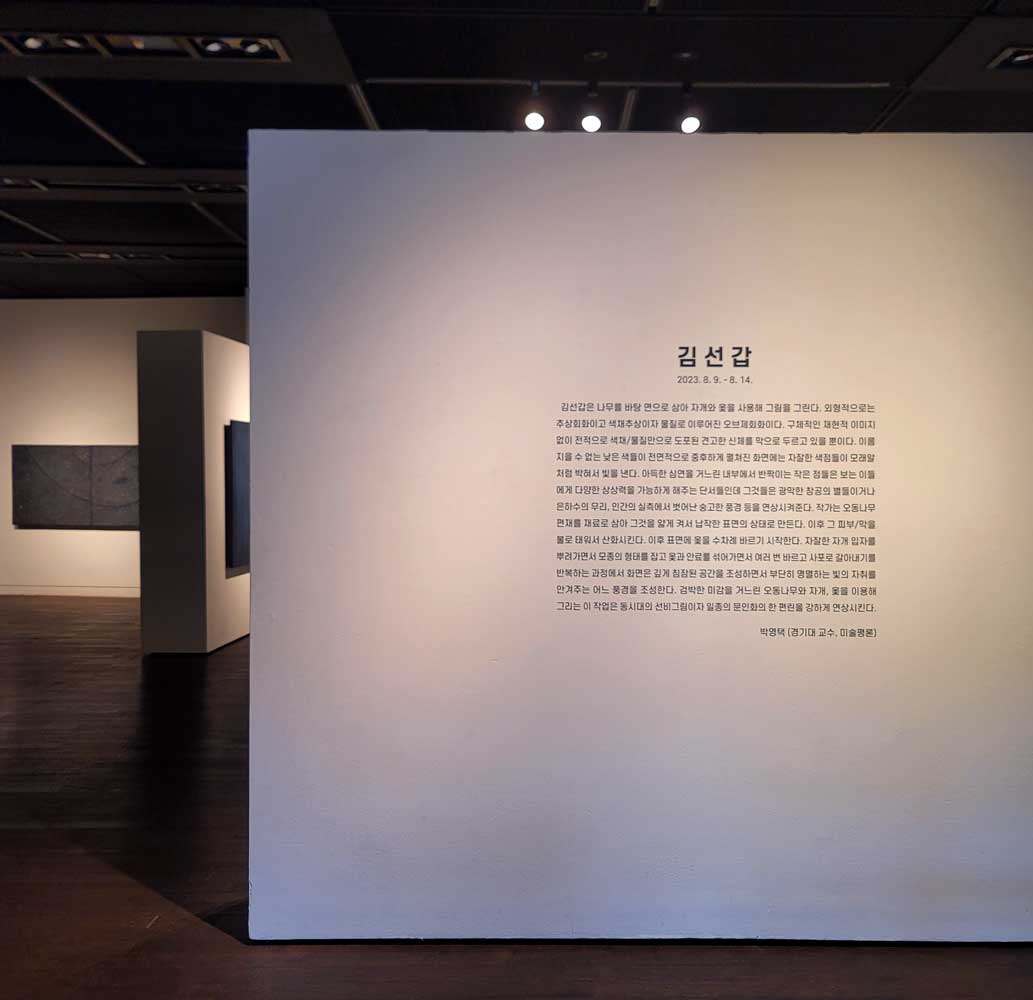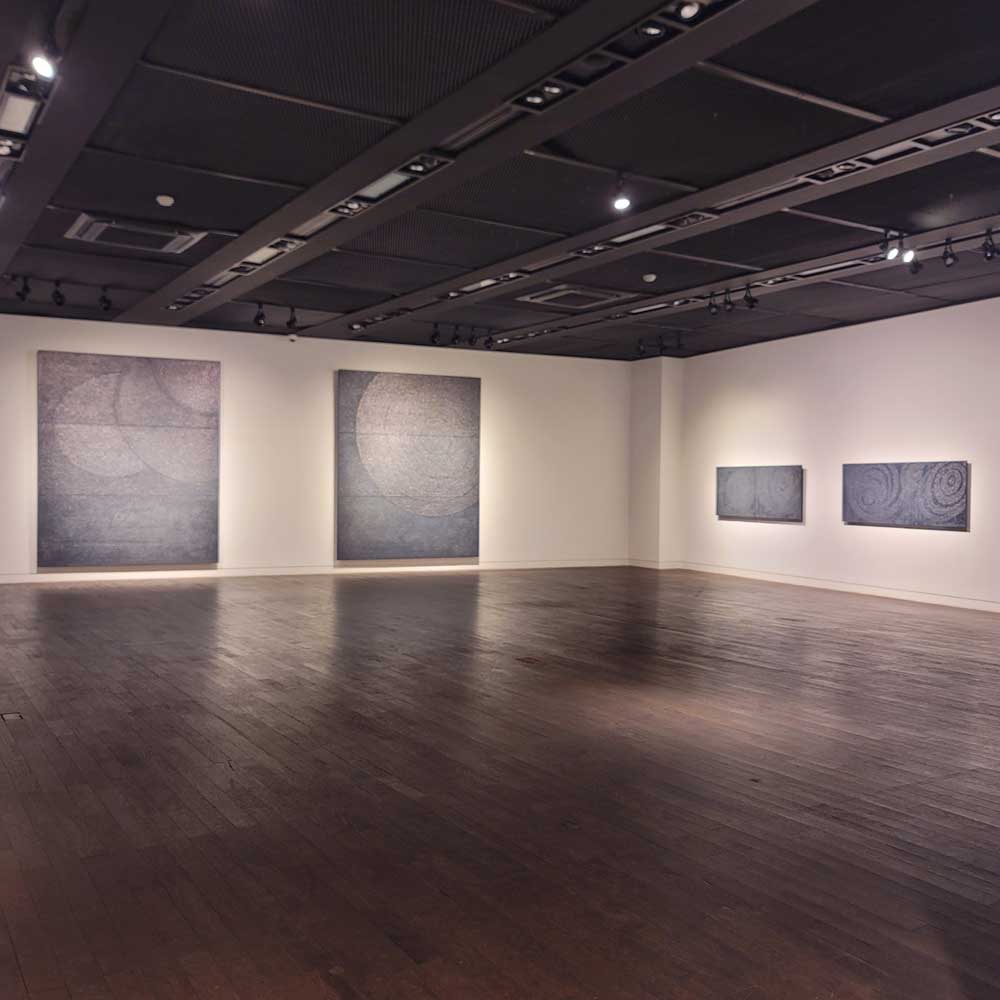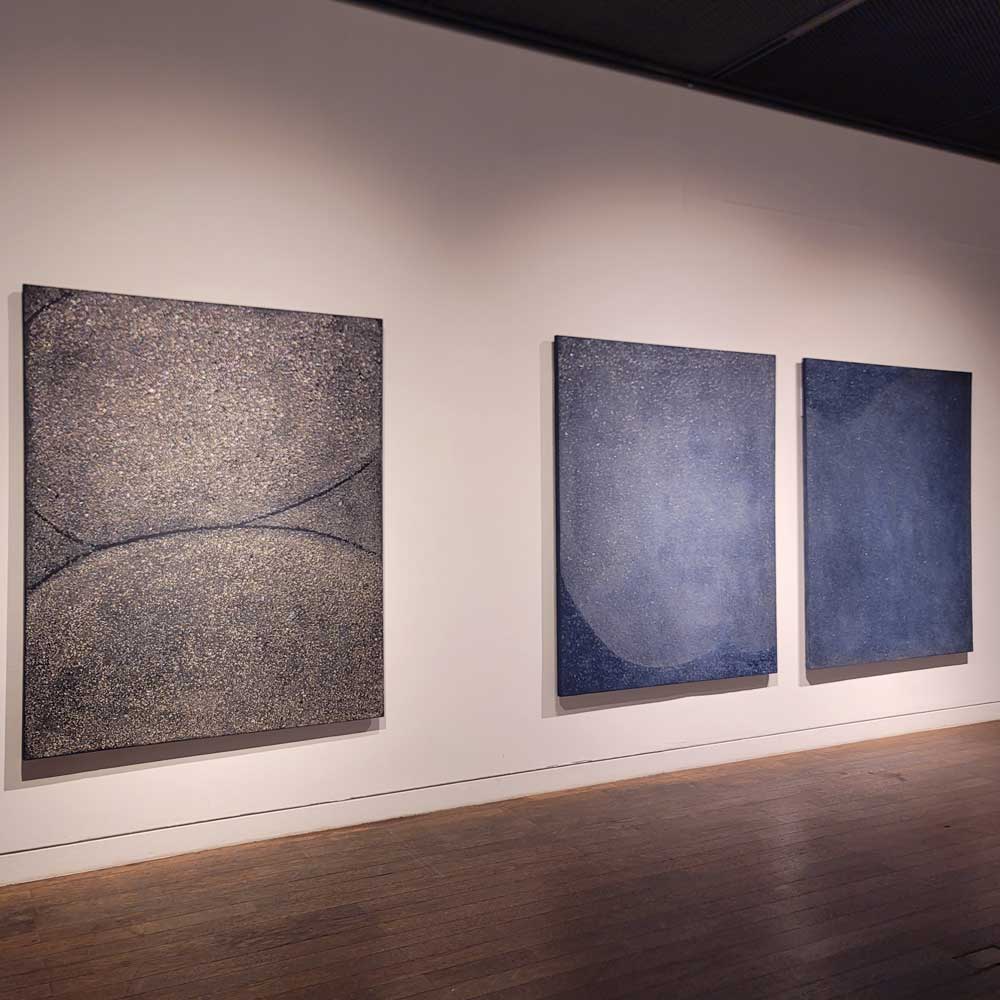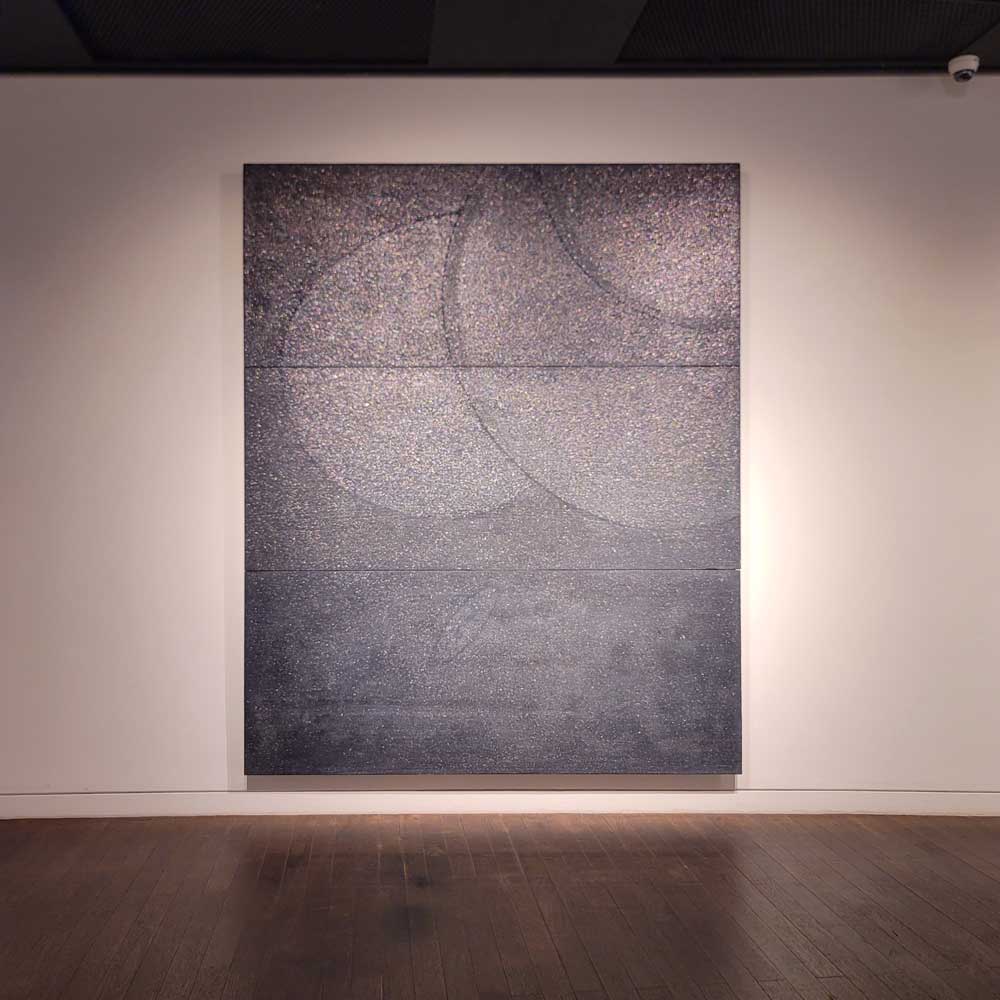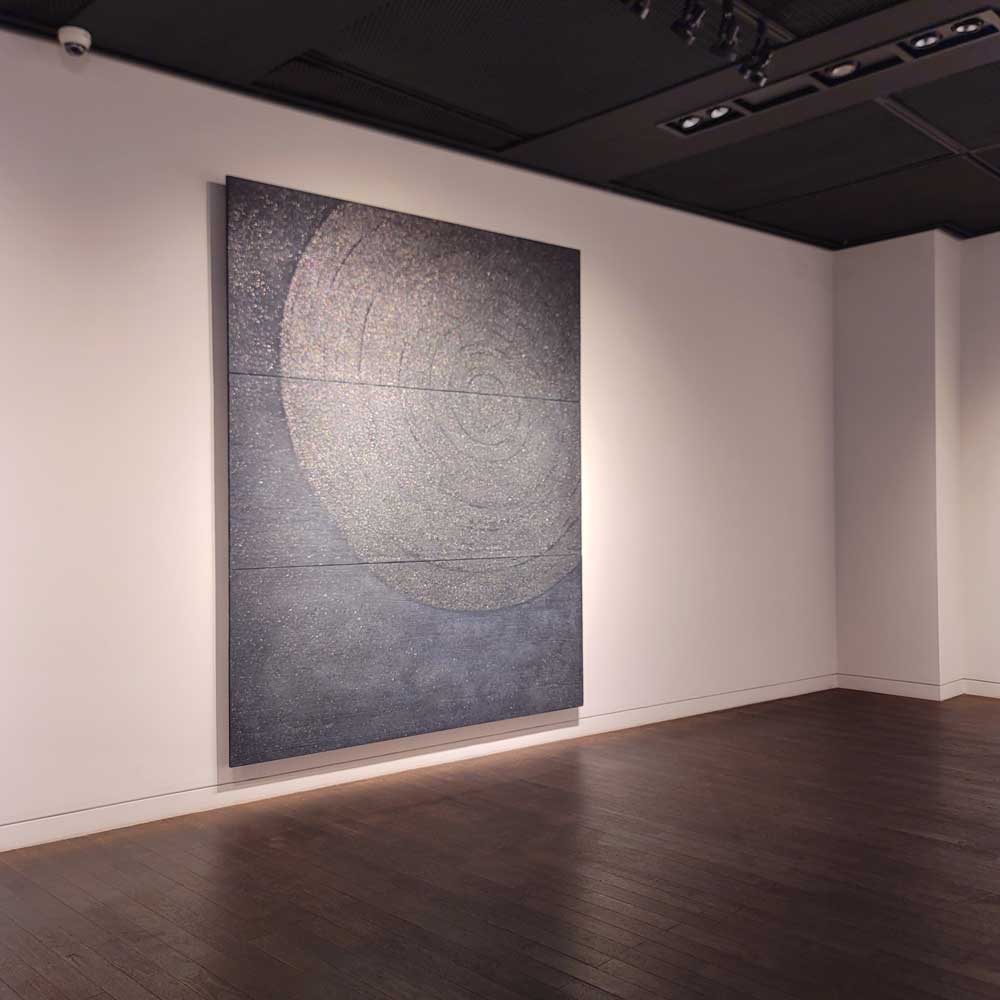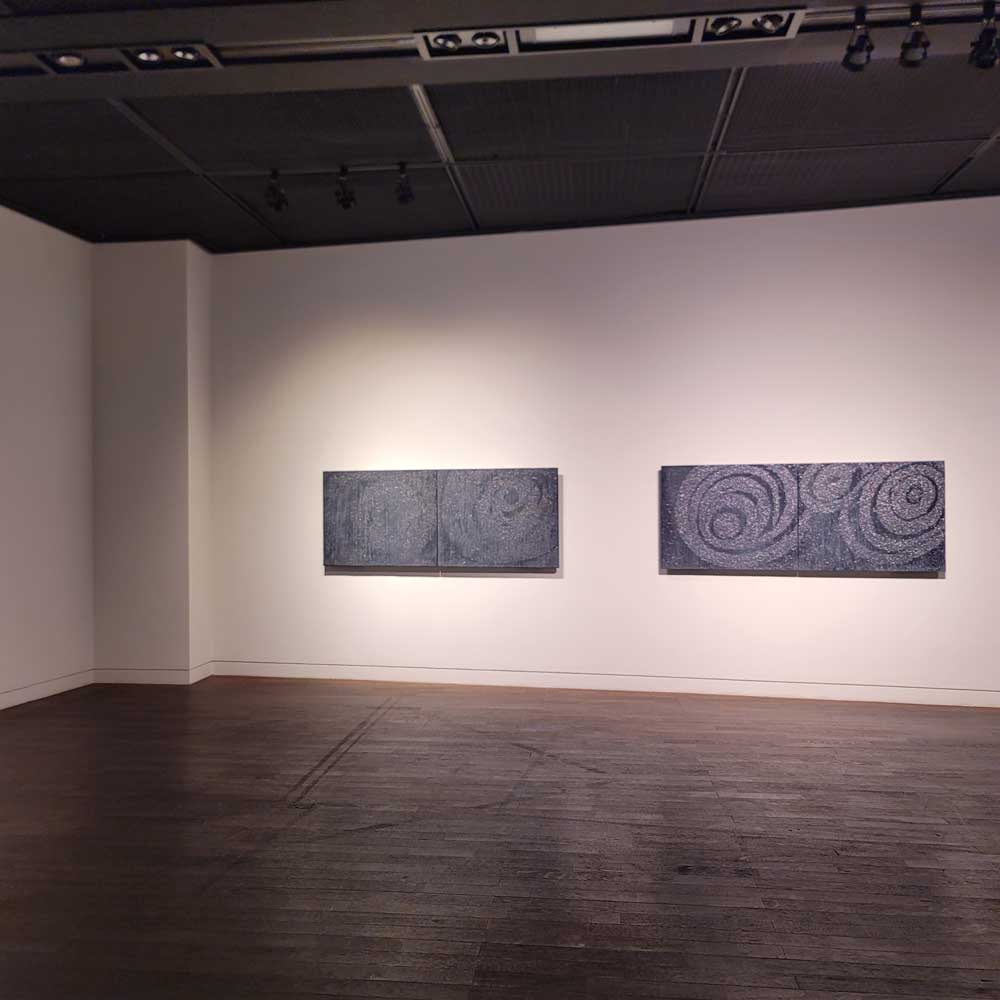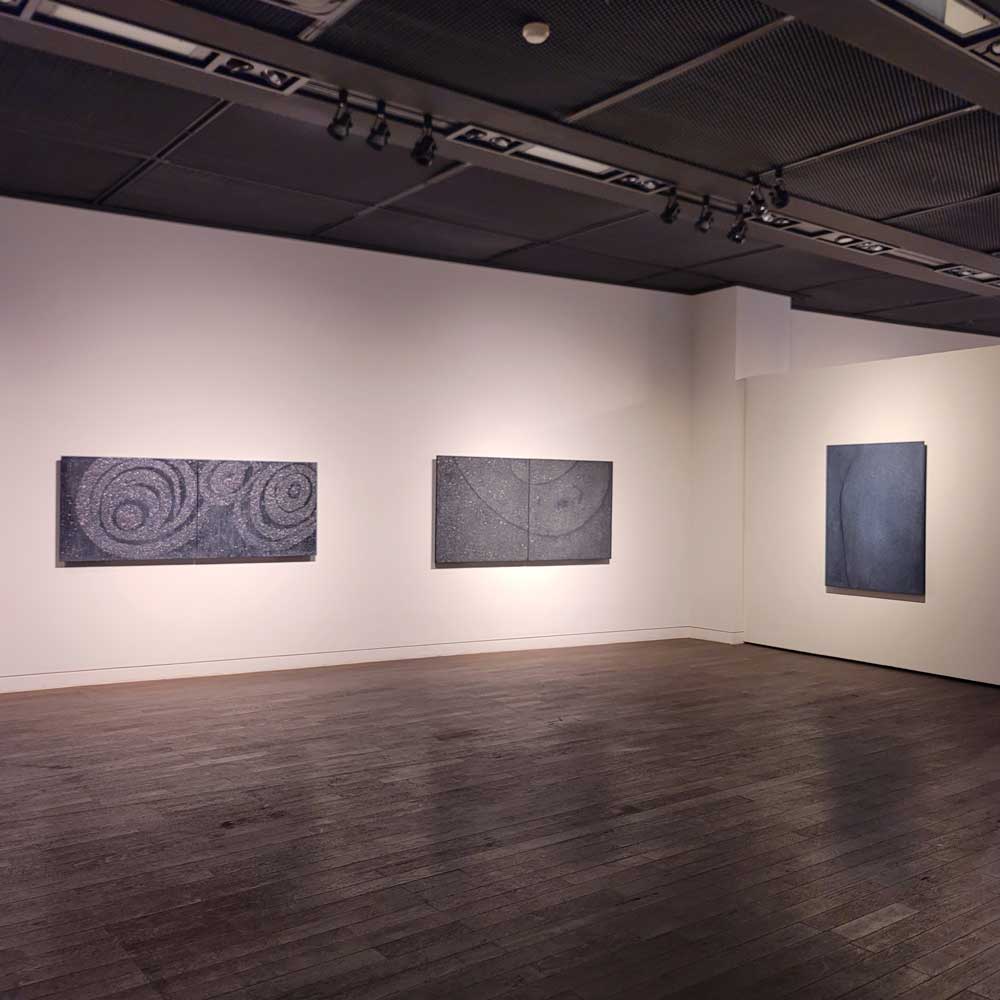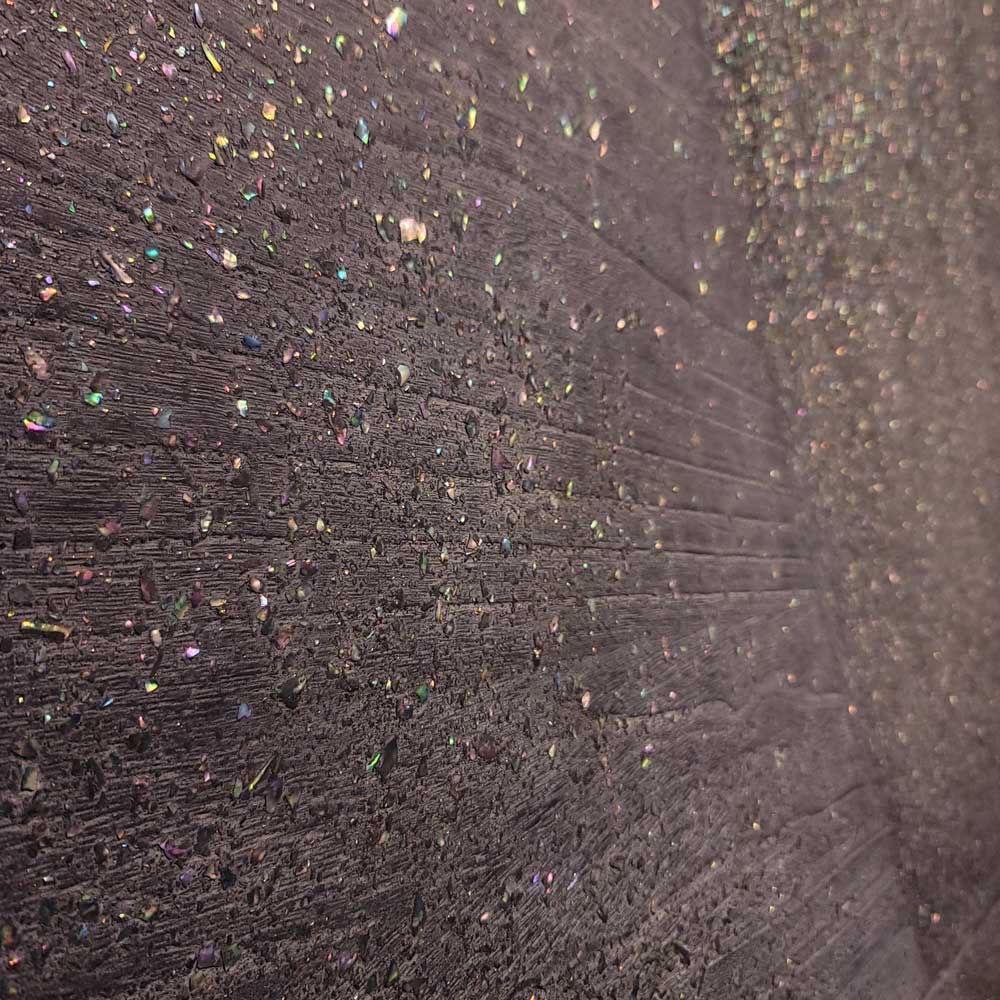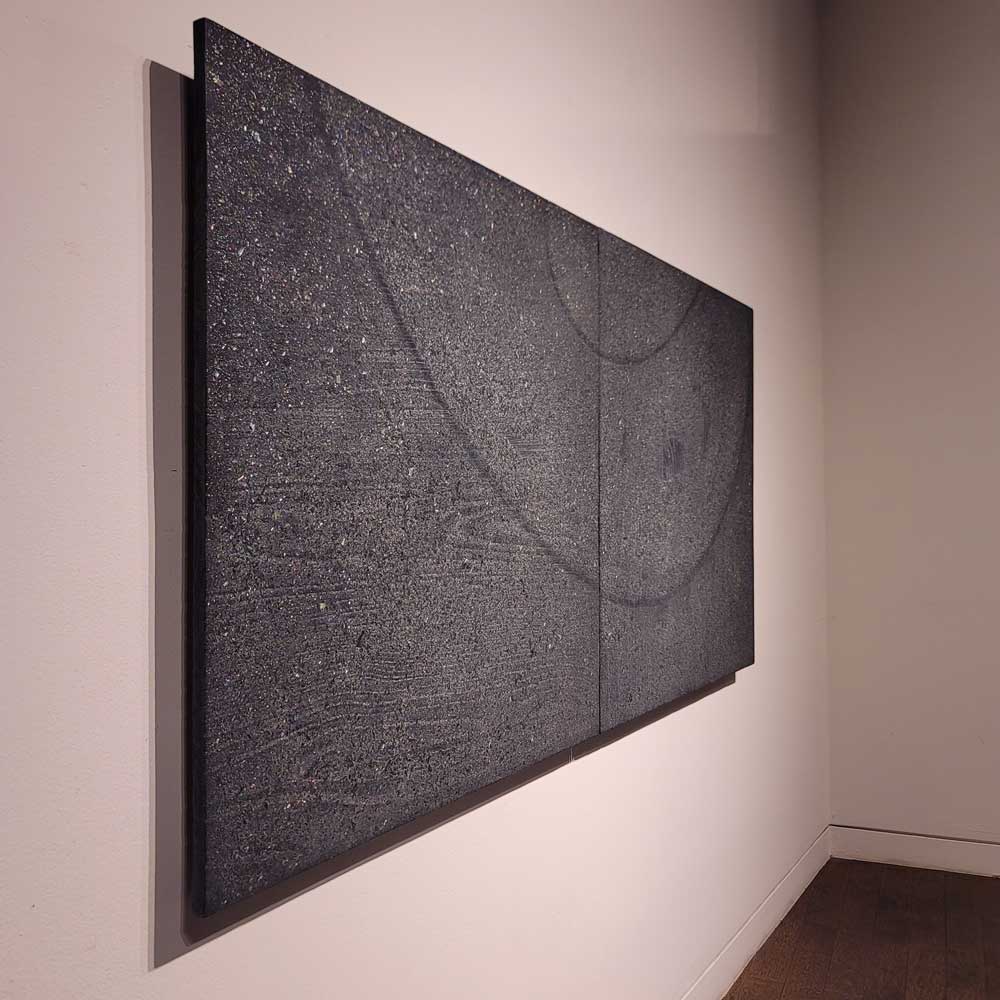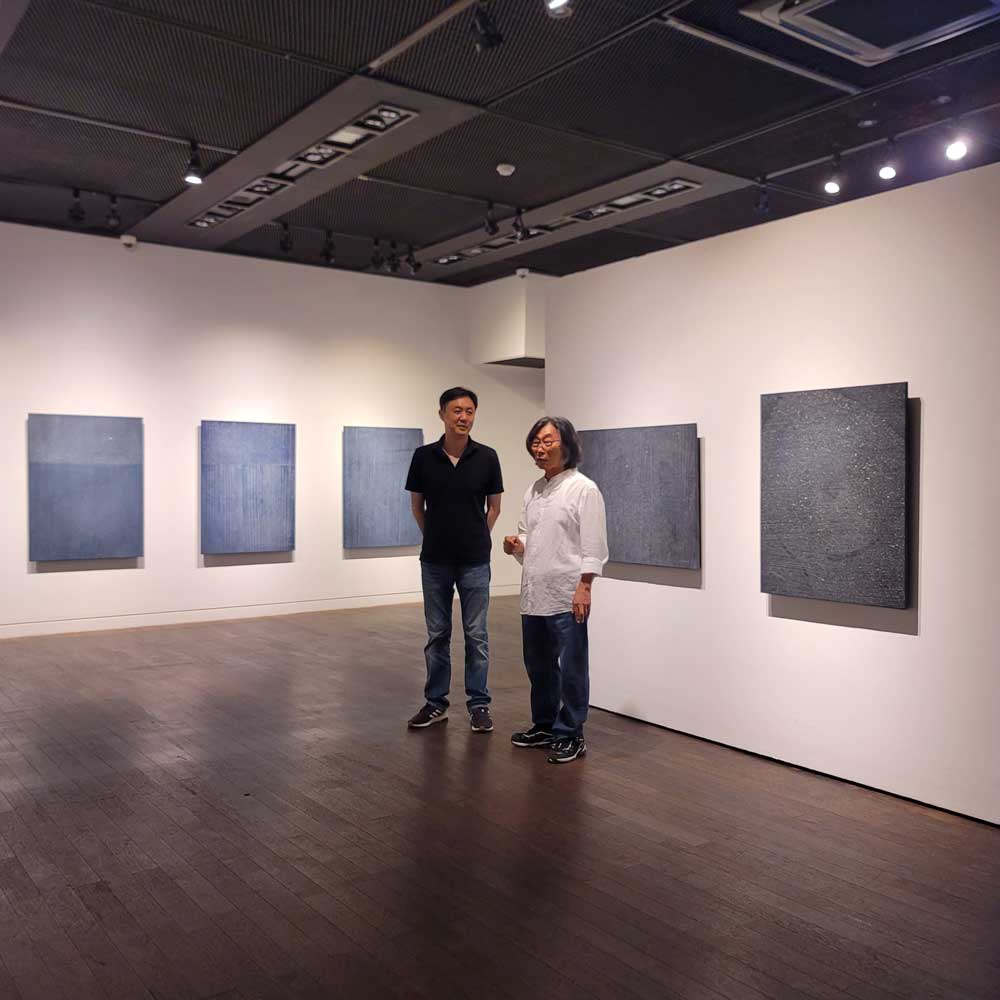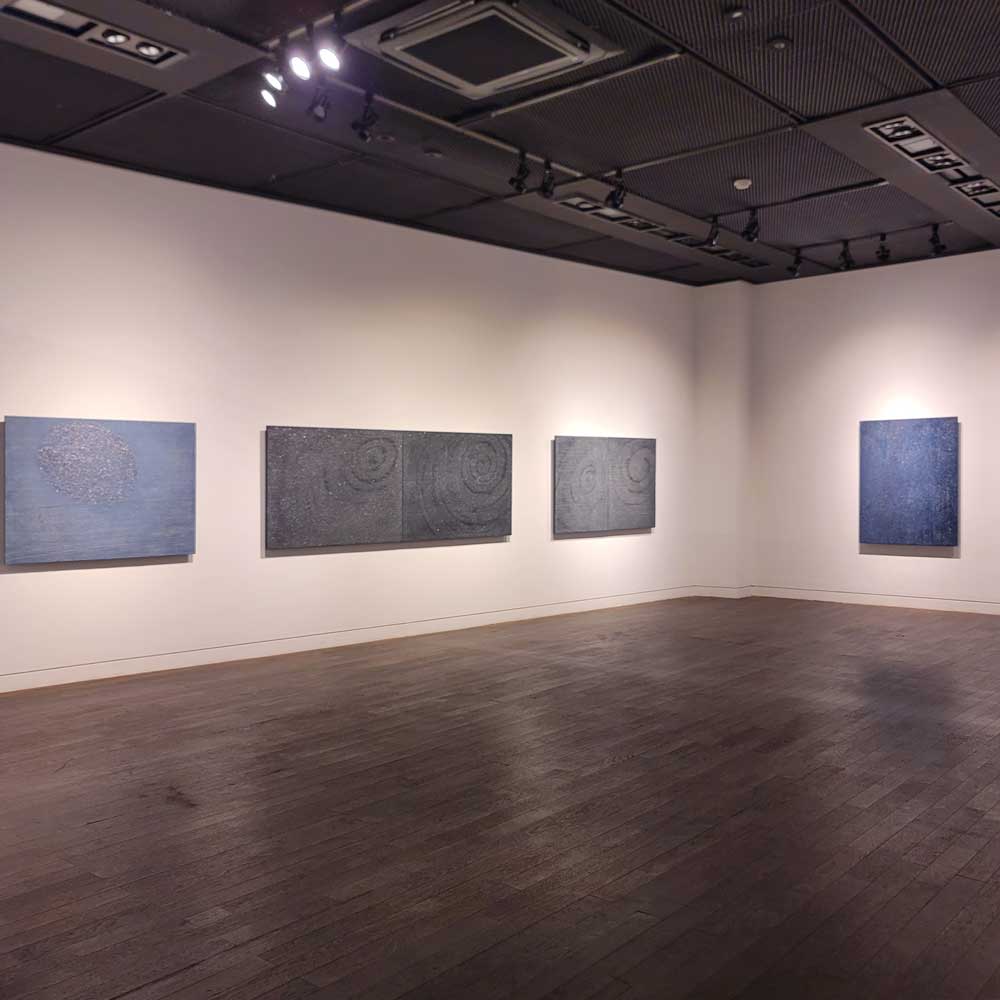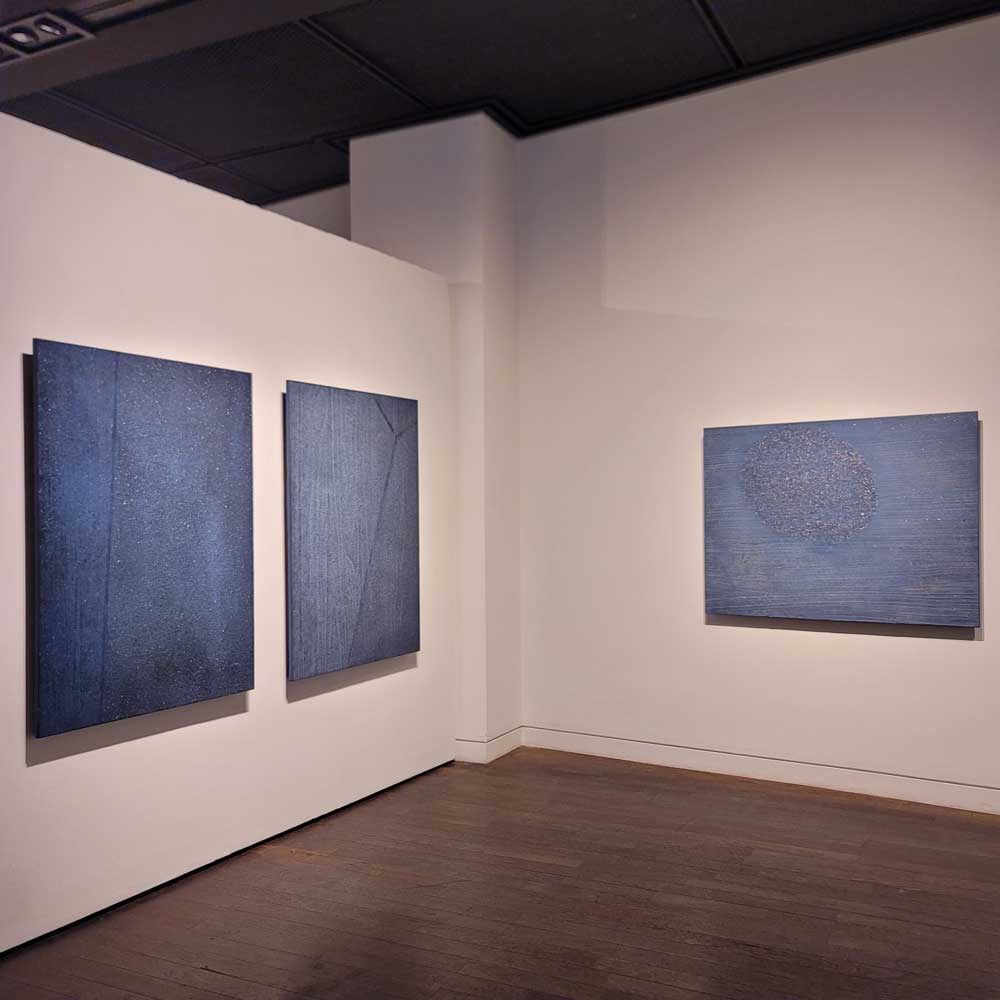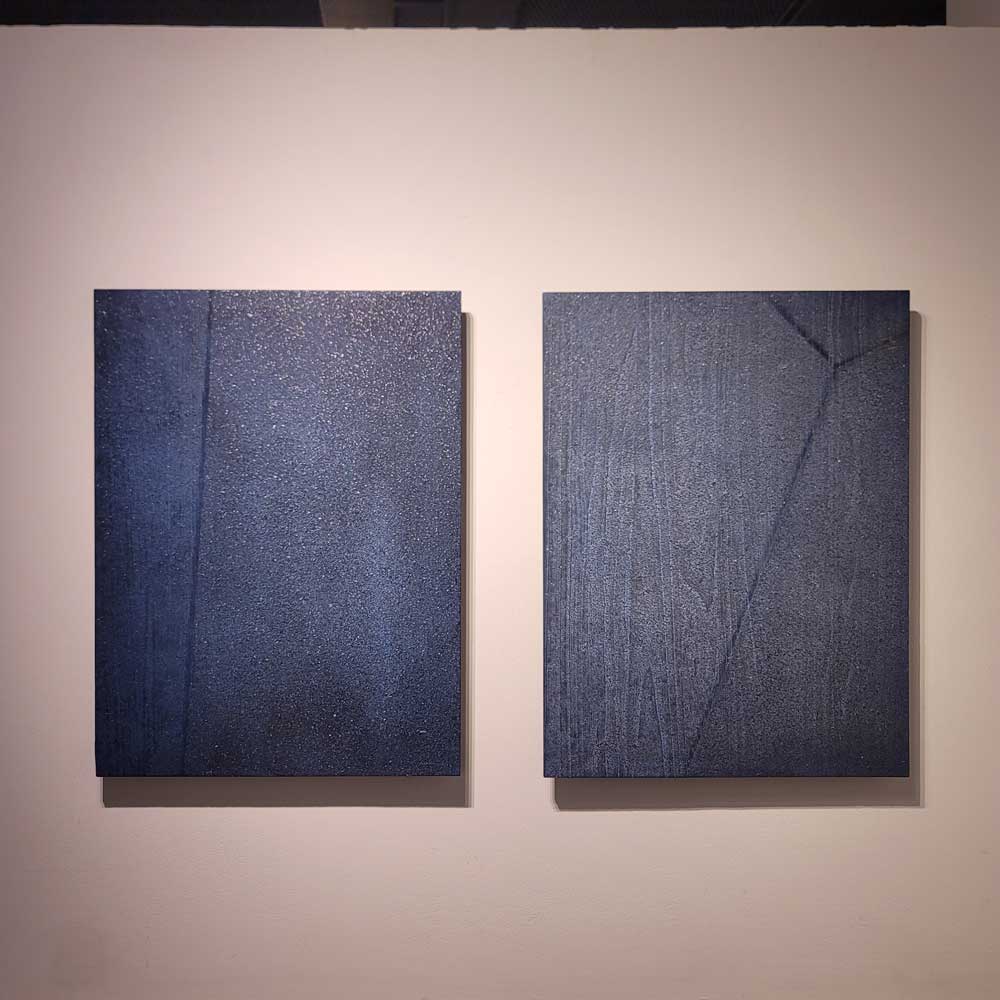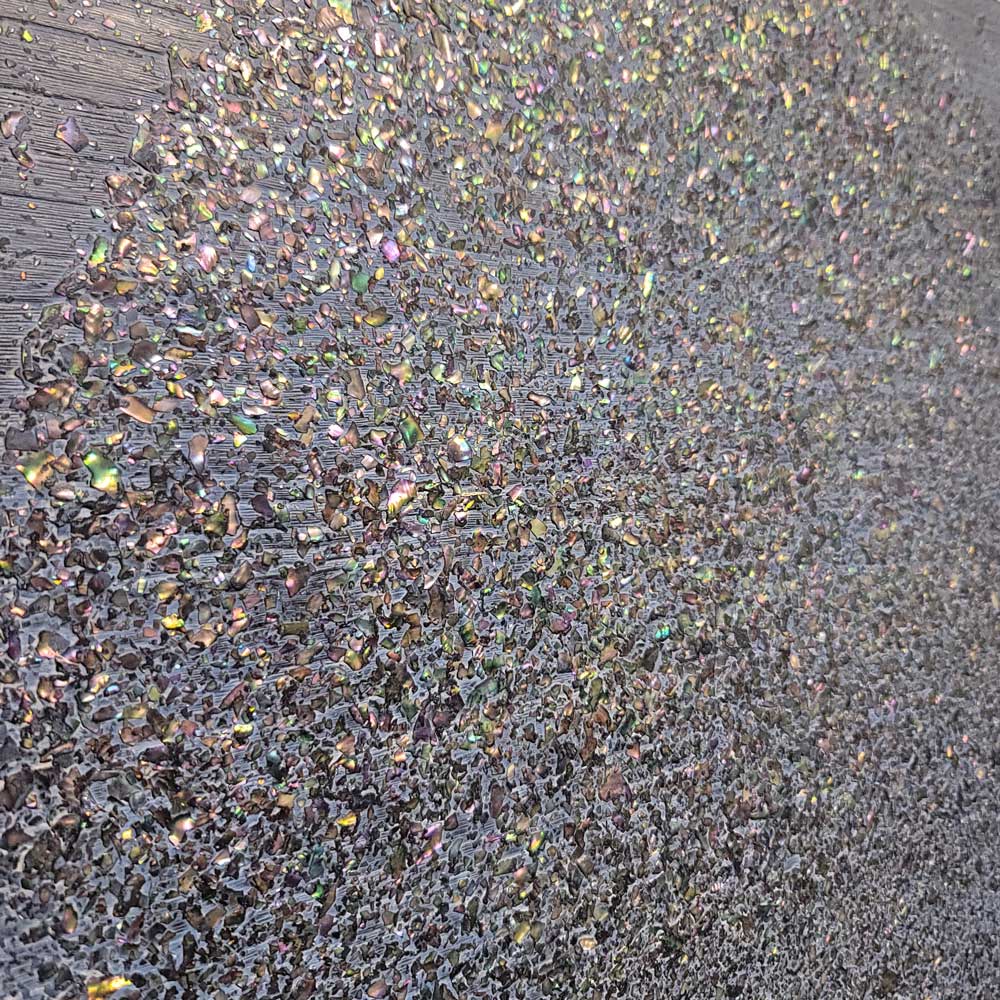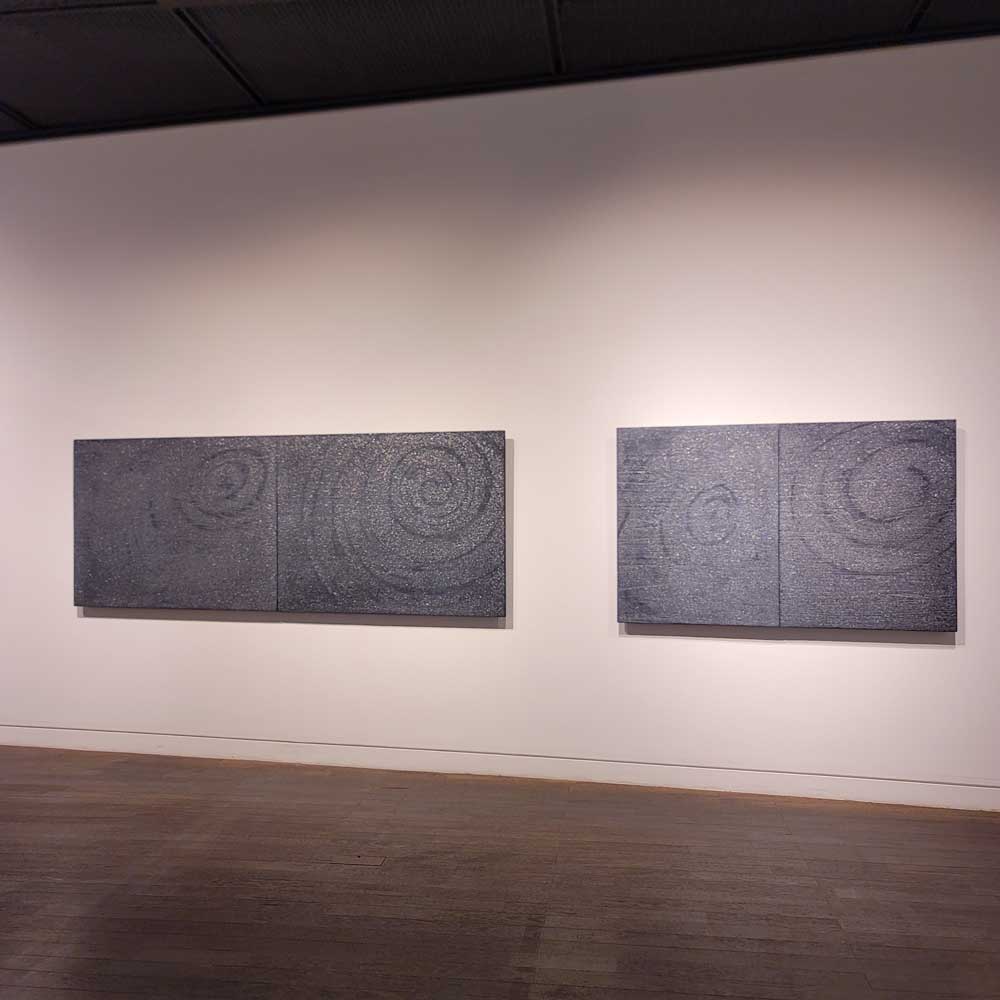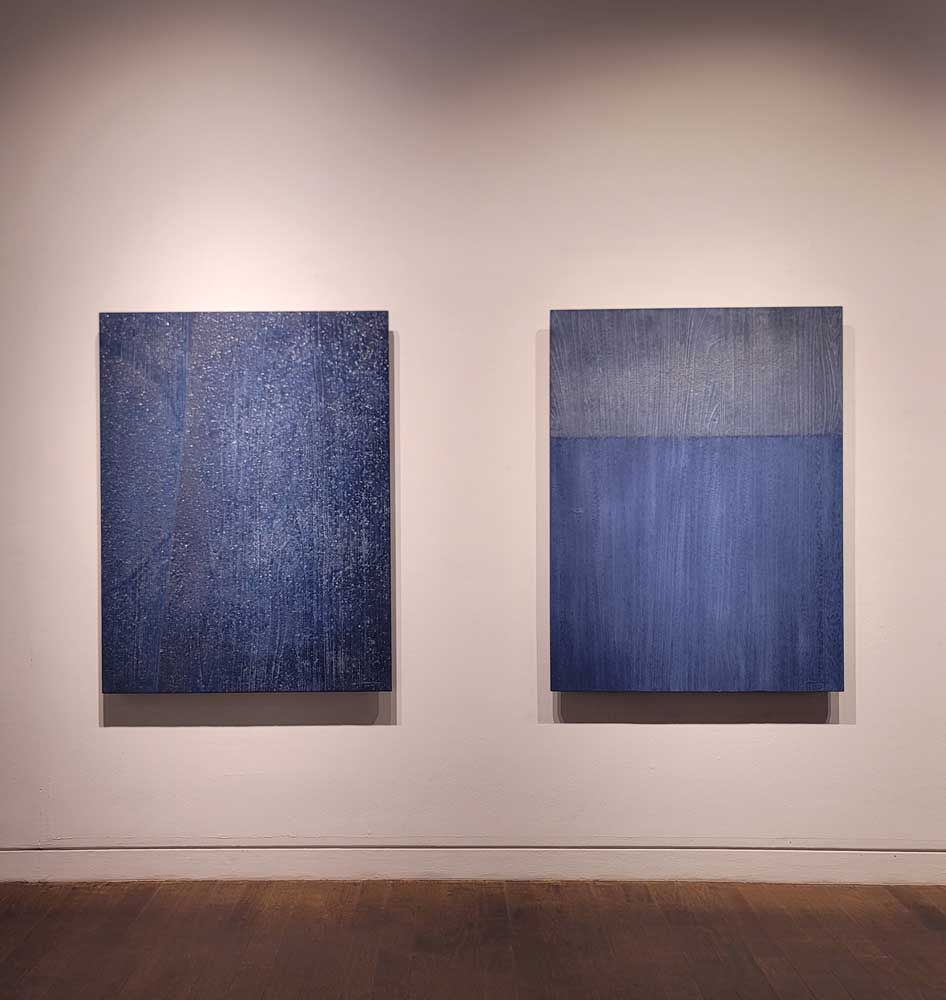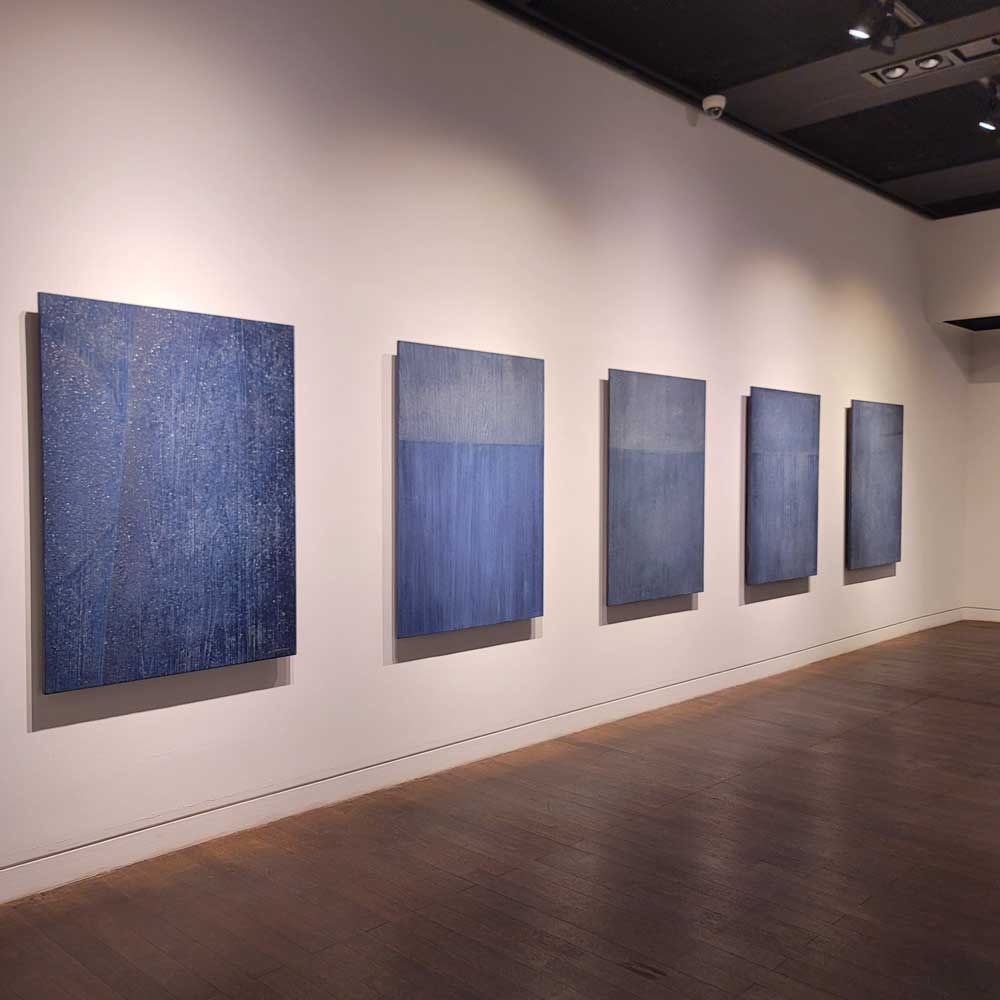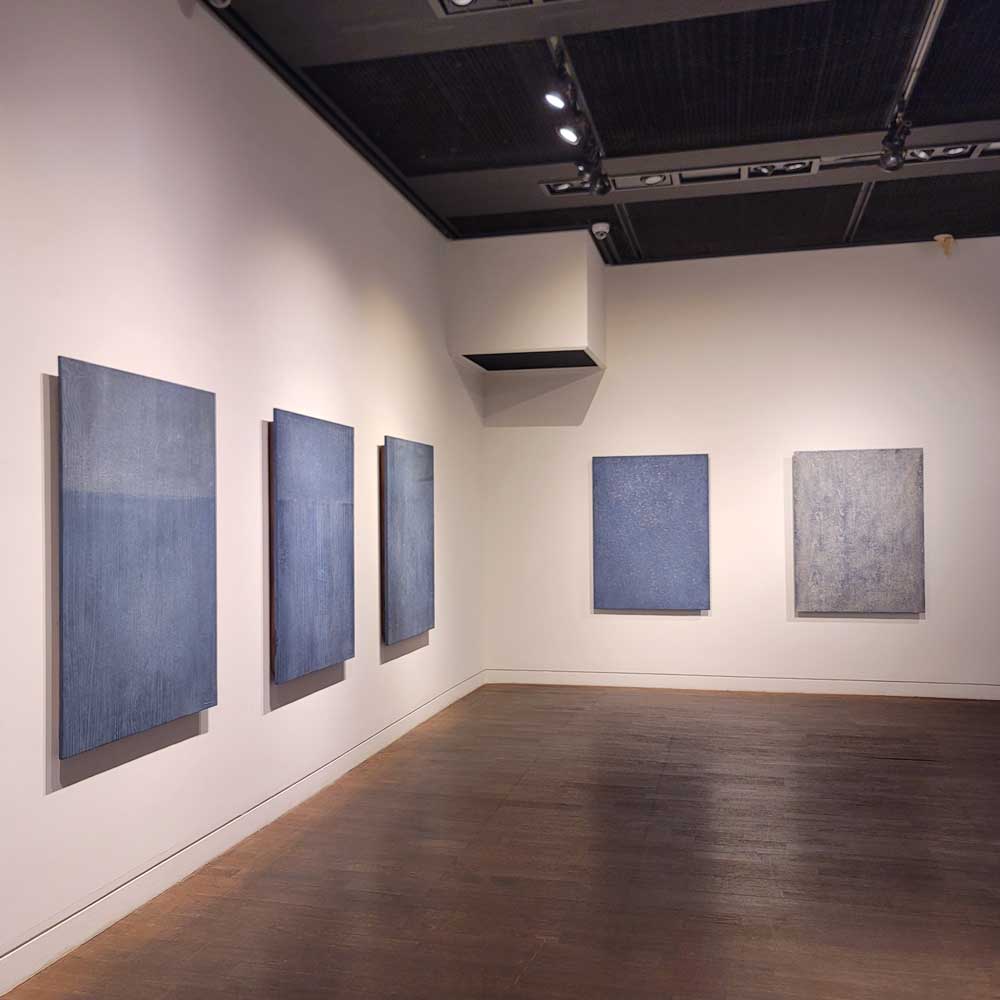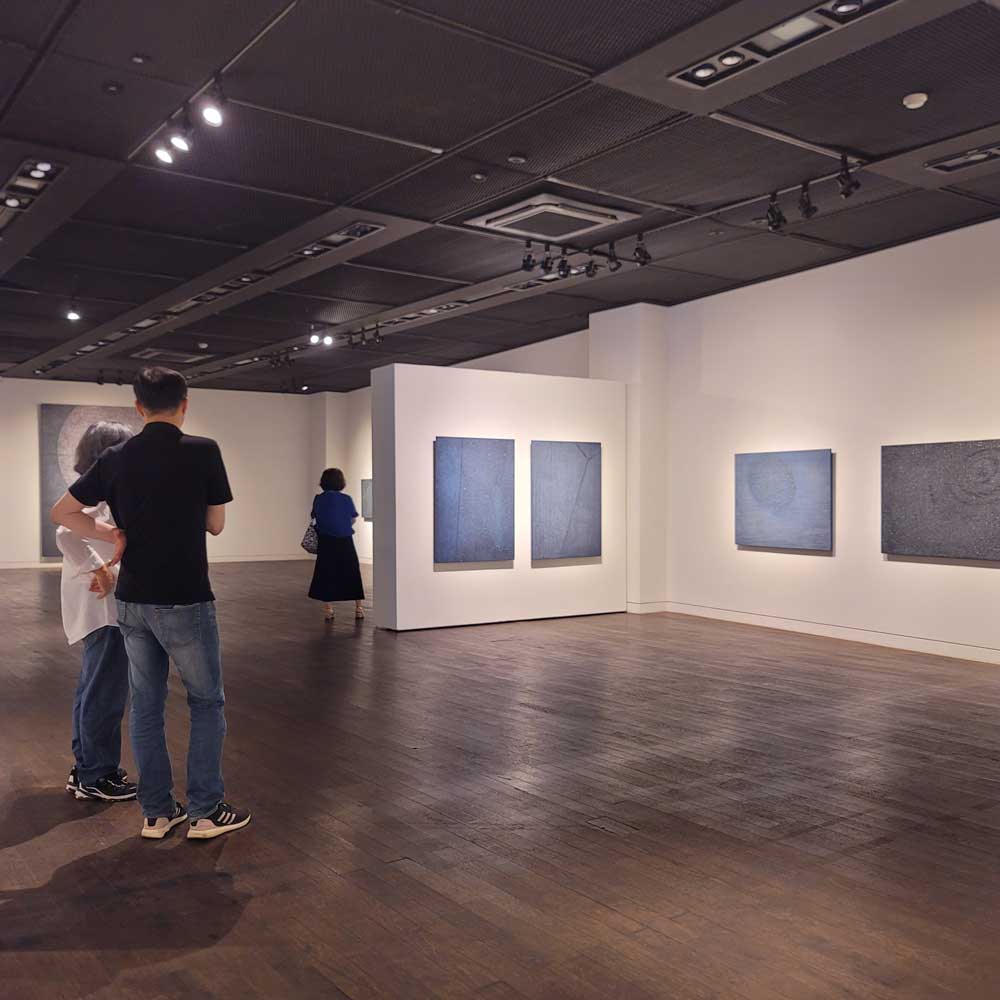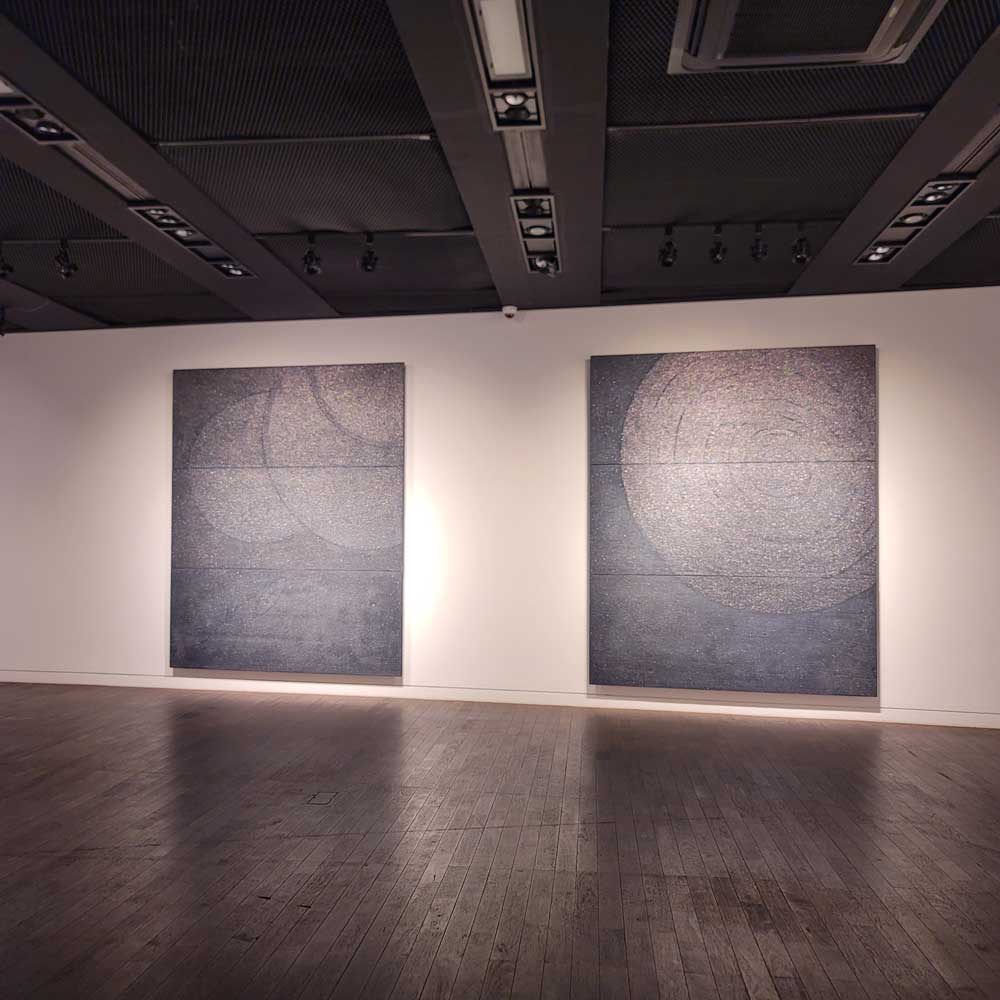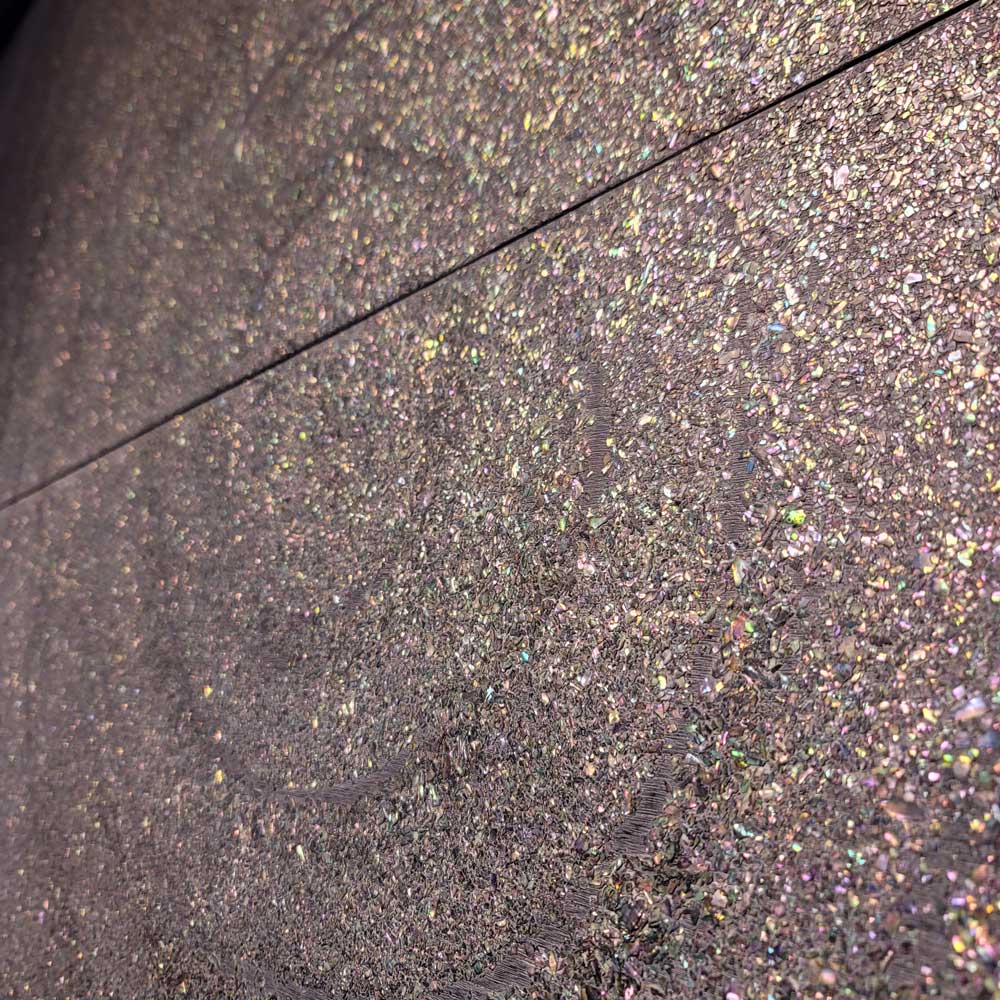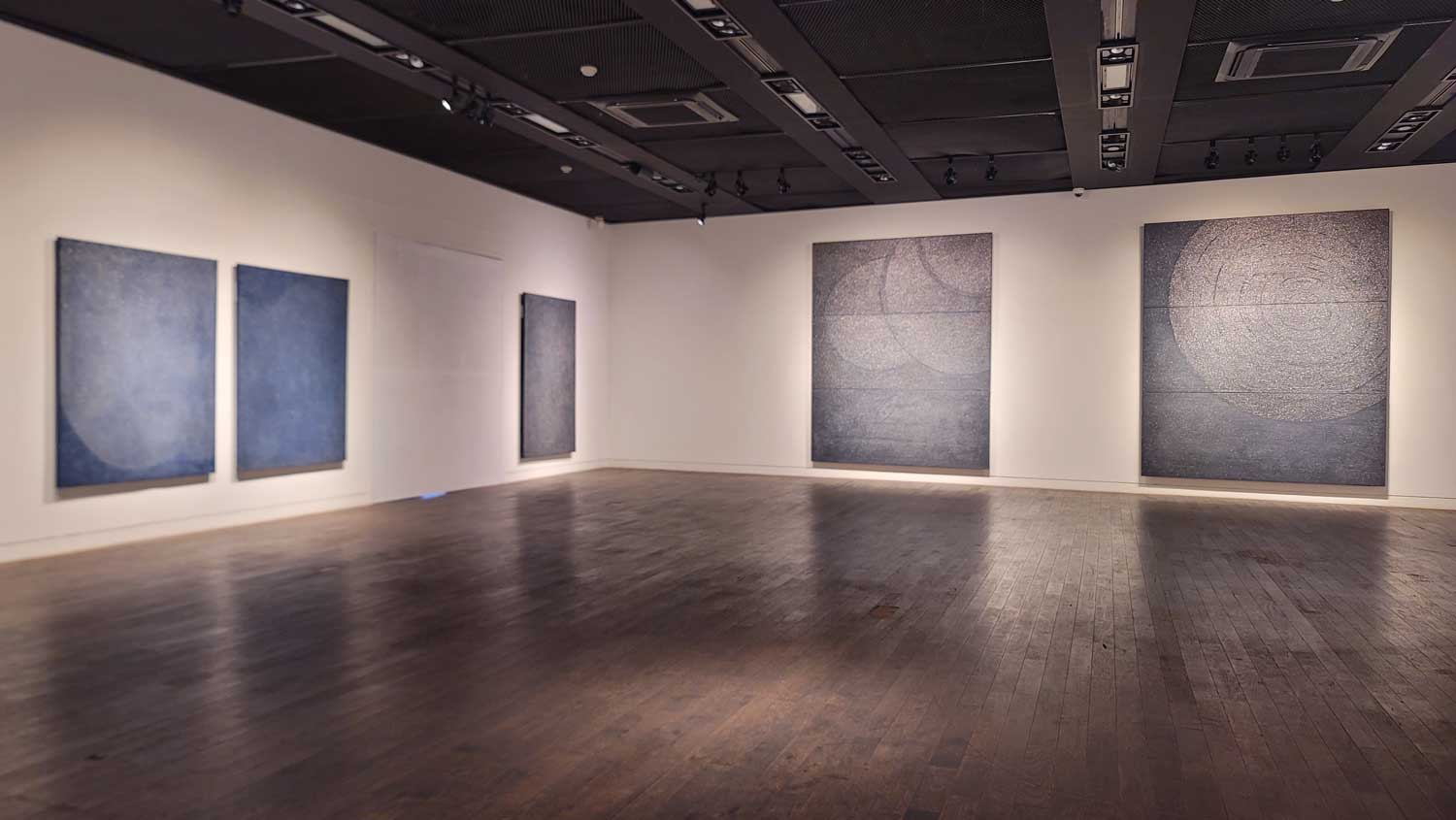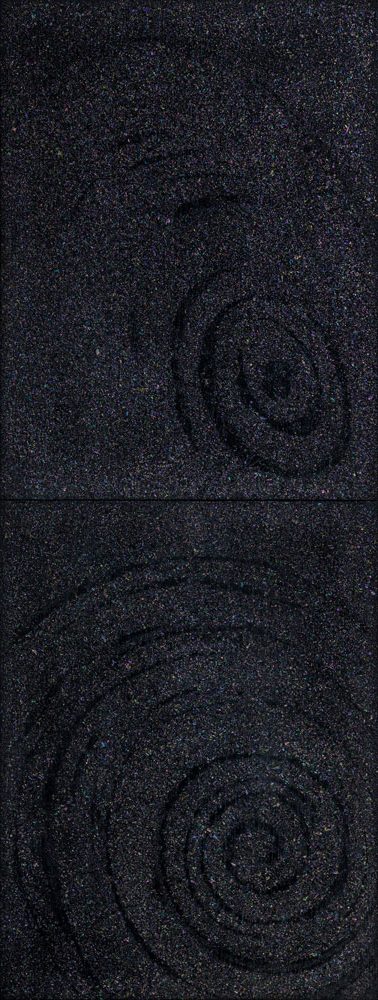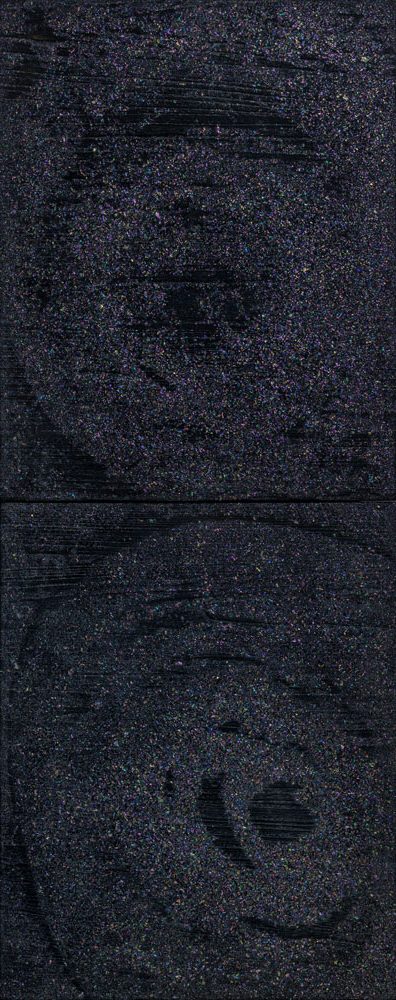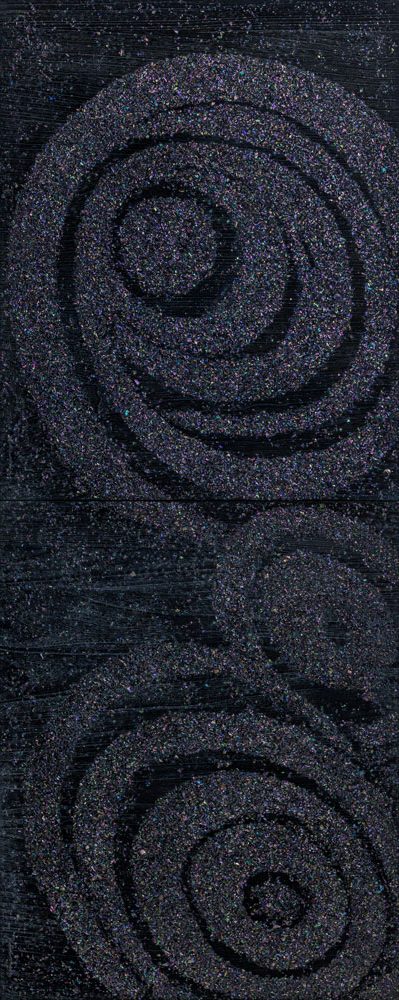자개와 옻으로 그려진 사의화
박영택 (경기대 교수, 미술평론)
김선갑은 나무를 바탕 면으로 삼아 자개와 옻을 사용해 그림을 그린다. 독자적인 회화적 피부를 조성해나간다. 그것은 외형적으로는 추상회화이고 색채추상이자 물질로 이루어진 오브제 회화이며 단색조에 해당하면서 미니멀한 구조를 거느리고 있다.
붓질이나 신체적 자취 혹은 표현적인 흔적이 부재하고 형상이나 구체적인 재현적 이미지 없이 전적으로 색채/물질만으로 도포된 견고한 신체를 막으로 두르고 있을 뿐이다.
전적으로 표면만을 지시하는 이 화면은 그러나 납작하고 평평한 물리적 평면으로서의 피부가 아니라 심오하고 깊은 내부를 삼킨 판을 광활하게 넓혀나간다. 그것은 상하좌우도 없고 시간과 방향 감각이 무의미한 우주 공간을 연상시킨다. 이름 지을 수 없는 심오하고 채도가 낮은 색들이 전면적으로 중후하게 펼쳐진 화면에는 자잘한 색점들이 모래알처럼, 사금파리 조각마냥 박혀서 빛을 낸다. 그러면 그 빛을 따라 모종의 이미지를 은연중 연상하거나 선을 그려보게 된다. 마치 별을 쫓아 별자리를 만들어나가듯이 말이다. 별자리는 별이 만드는 것이 아니라 인간의 시선이 만든다고 했듯이 결국 이 그림은 관객의 적극적인 참여와 상상력의 개입으로 가능한 작업이 된다.
작가는 캔버스 대신에 견고하고 단단한 나무의 표면을 지지체로 삼 아 그 위에 자개 입자를 뿌리고 옻과 안료를 섞어 이를 고착시켰다. 그렇게 이룬 표면은 물질과 색채가 혼재되어 있고 중심과 주변의 경계가 모호한 체 어둠 속에서 명멸한다. 아득한 심연을 거느린 내부에서 빛나는 작은 점들은 보는 이들에게 다양한 상상력을 가능하게 해주는 모종의 단서들이다. 그러나 그것이 곧바로 특정 재현의 대상으로 가닿는 것은 아니다.
그 점, 입자들은 짙은 어둠 속이나 가라앉은 색채의 더미 속에서 그저 은밀하게 숨 쉬고 있을 뿐이다. 밝음의 상태, 반짝이는 어느 순간, 또는 작고 작은 조각들과 무수한 편린들로 그저 부유하고 있다.
화면 안에는 원형의 곡선을 지으며 선회하거나 반원의 형태를 짓거나 또는 둥근 유선형의 꼴을 만들기도 하고 소용돌이치는 선들의 궤적을 그려 보이거나 화면을 가로질러가는 직선 또는 사선만이 자리하고 있다. 그 부드러운 곡선과 단순한 직선의 흐름과 율동이 오동나무의 결(무늬)과 그 위를 점유하고 있는 단색조의 색층을 분할하면서 지나간다. 그러한 궤적은 마치 모필에 의한 한 획의 스침이나 바람의 결, 우주의 파동, 에너지/기의 흐름 등을 연상시킨다.
그렇지만 무엇보다도 짙게 가라앉은 색조의 화면 위로 부서지며 반짝이는 자개 입자들이 보여주는 풍경은 흡사 광막한 창공에 떠 있는 별들이거나 은하수의 무리, 인간의 실측에서 벗어난 우주의 풍경 같은 것이, 설핏 연상될 뿐이다. 그것은 눈으로 본 풍경이 아니라 마음이 그려본 장면 내지는 상상력에 의해 가설된 허구적 장면일 것이다. 작가는 화면을 바닥에 수평으로 눕혀 일치시킨 후에 그 위에서 자개의 입자를 뿌린다. 흘린다. 중력의 법칙에 의해 가는 자개 가루들은 바닥을 향해 낙하하고 흩어진다. 가루를 흘려가면서 모종의 형태를 잡아내거나 이미지를 그려나가는 이 일은 핑거페인팅에 해당하는 방법론과 유사하다. 직접 화면에 그림을 그리는 것은 아니지만 여전히 손의 예민한 감각에 의지해 자개 가루를 분사, 투여하고 그것을 고정시키고 옻을 바르는 일을 반복하면서 평면 위에 부조화(릴리프) 시키는 일을 반복해서 작업을 진행한다. 그로 인해 표면에서 일정한 높이를 지니며 제각기 다르게 솟아오르는 자개들은 촉각적인 감각을 자극하며 발아한다. 그러나 사포로 갈아낸 표면은 비교적 균질하게 마감되어서 크기가 다르고 형태가 비균질적인 여러 자개의 양태를 가능한 고른 피부 위로 수렴시키고 있다. 입자를 뿌려가면서 모종의 형태를 잡아가고 옻과 안료를 섞어가면서 여러 번 바르고 사포로 갈아내기를 반복하는 과정에서 화면은 깊게 침잠된 공간을 조성하고 있다.
작가는 오동나무 판을 재료로 삼아 이를 화면으로 다루고 있다. 그것을 비교적 얇게 켜서 납작한 표면의 상태로 만든다. 이후 그 피부/막을 불로 태워서 산화시킨다.
오동나무를 태우면 비로소 그 나뭇결이 선명하게 몸을 내민다. 그러니까 이른바 ‘그림’이 드러난다. 오동나무의 피부를 태워 탄소화시키고 표면이 숯이 되면 이른바 수축현상이 방지되는 한편 오동나무 특유의 매력적인 선이 드러나기에 이를 적극 활용한다고 한다. 이후 작가는 오동나무의 표면에 옻을 바르기 시작한다. 5회에서 10회에 이르기까지 반복해서 옻을 올린다. 질감을 만들어가는 한편 그 위에 얹혀지는 자개의 두께를 고려하면서 옻은 올라간다. 우리 선조들은 오동나무를 서류나 의복, 중요 기물 등 습기에 약한 물품들을 보관하는 데에 제격인 목재로 여겼다. 특수 섬유질로 인해 건습 조절이 용이하기에 그렇다. 특히 판재의 표면이 검고 광택이 없어 검소한 분위기를 추구하는 사랑방에 자리하는 용품 재료로서 적당하기에 조선시대 선비들의 사랑을 받은 특별한 목재였다.
김선갑이 이 오동나무를 재료로 사용하는 주된 이유는 특히 이 선비들의 미감, 미의식과 연관되어 있다. 강직하고 안정된 선비의 단아한 미의식과 함께 외형보다는 내적인 아름다움, 인위적인 것보다는 자연의 미를 추구하는 것이 조선시대 선비문화의 정수다.
바닥 면과 일치된 화면에 모필을 갖고 일획의 붓질을 하듯 선을 치는 행위, 그리고 자연의 재료를 갖고 그것의 본질을 고수하면서 인위성을 최대한 억제하면서 다루고 아울러 자연의 이치를 궁구하며 그 본성을 작업 제작 방식과 주제의식으로 고스란히 일치하려는 시도 등에서 전통적인 동양화 제작 방식과 김선갑 작업의 유사함을 생각하게 한다. 작가는 자신의 작업을 일종의 문인화, 수묵화와 같다고 말한다. 옻과 자개를 이용한 문인화 내지 회화 작업이라는 것이다. 그래서인지 그는 유독 문인화 정신을 강조한다.그는 선비정신의 강직함과 검박함, 절제된 미감과 청빈함, 격조 있는 미감을 자기 작업의 중추로 삼고 있어 보인다. 그것이 현재 단색조의 색채 미감과 미니멀한 구성과 절제된 화면 연출 등에서 시연되고 있다는 생각이다. 그리고 그는 오랜 기간 산수화를 그려왔고 문인화를 해온 경험, 이력이 지금 작업의 바탕이 되어주었음을 강조해서 말하고 있다. 오동나무에 자개와 옻을 이용해 그리는 나름의 선비 그림, 내지 문인화에 해당하는 회화가 이런 식으로 몸을 내밀고 있다.
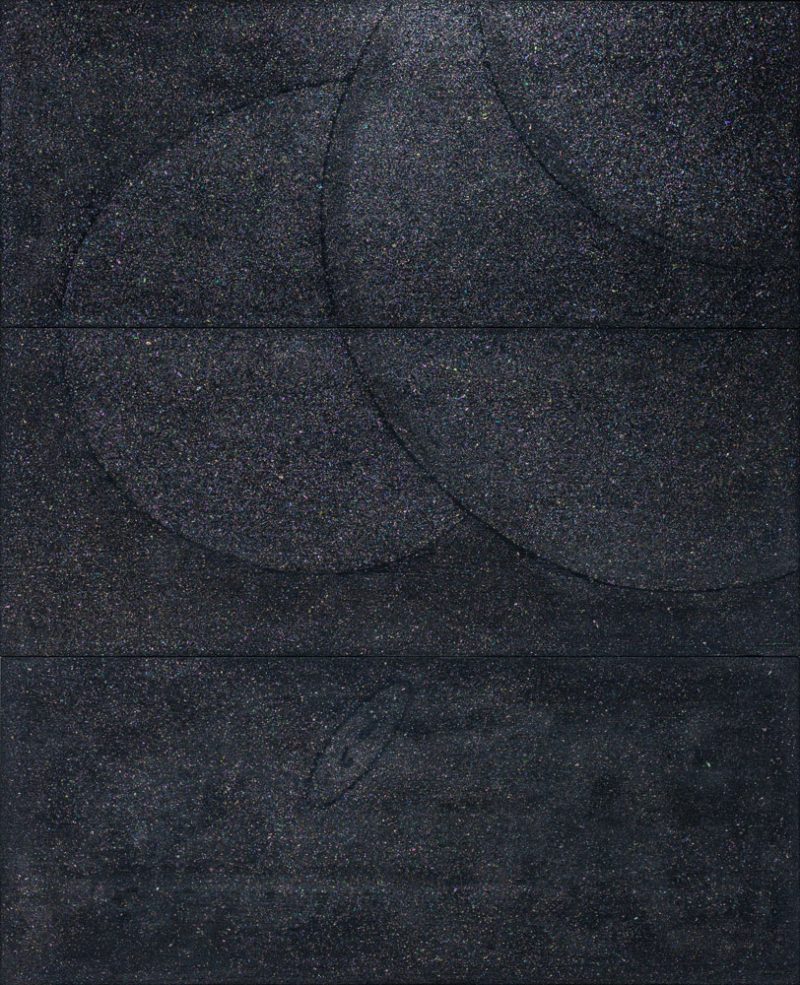
Work
270×220cm 자개,옻,목재 2023
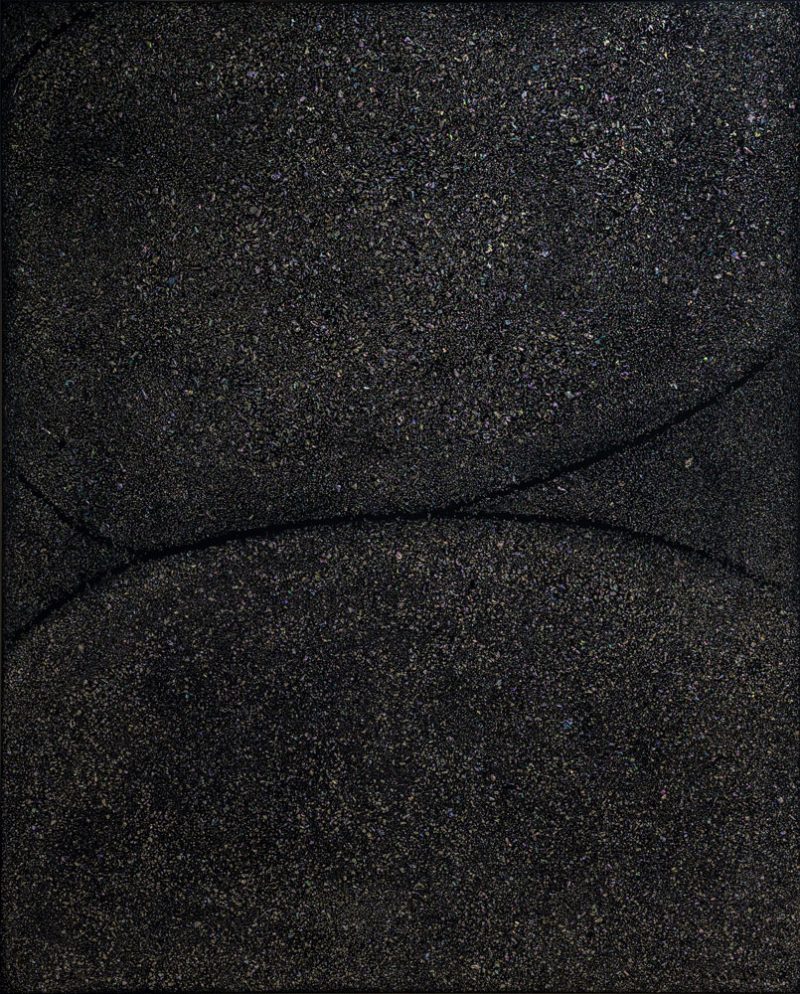
Work
162.2×130.3cm 자개,옻,캔버스 2023
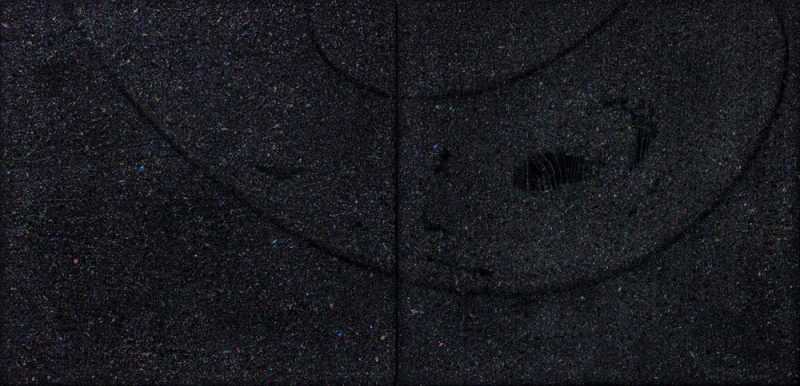
Work
90.5×181.5cm 자개,옻,목재 2023
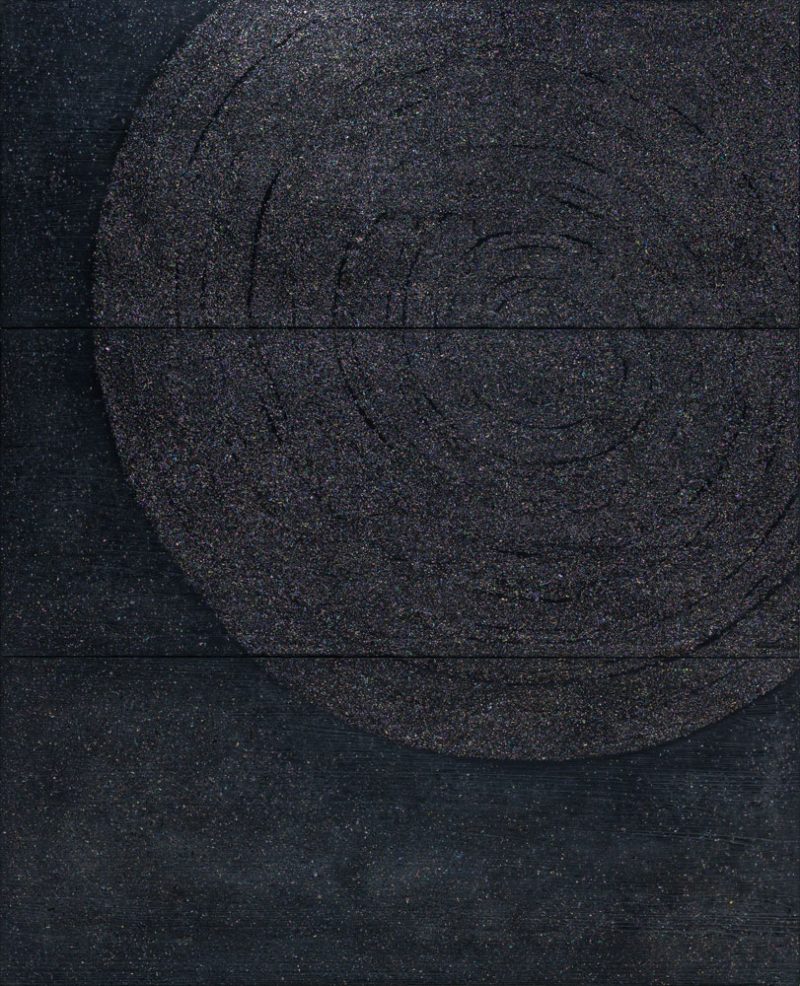
Work
270×220cm 자개,옻,목재 2023
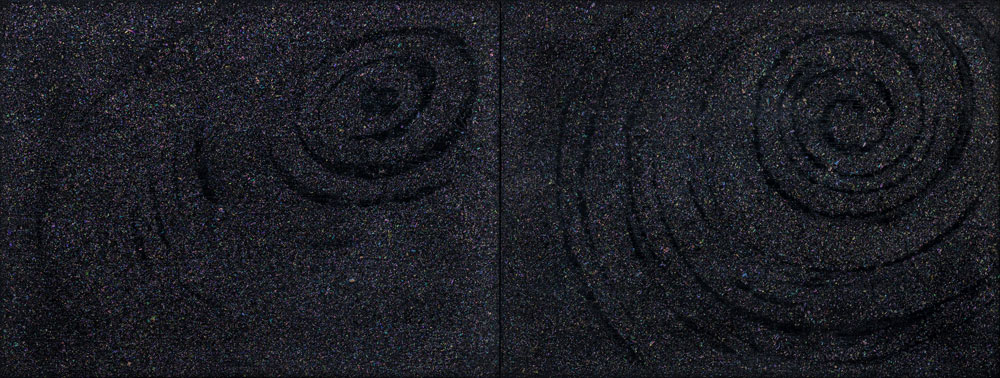
Work
73×183.5cm 자개,옻,목재 2023
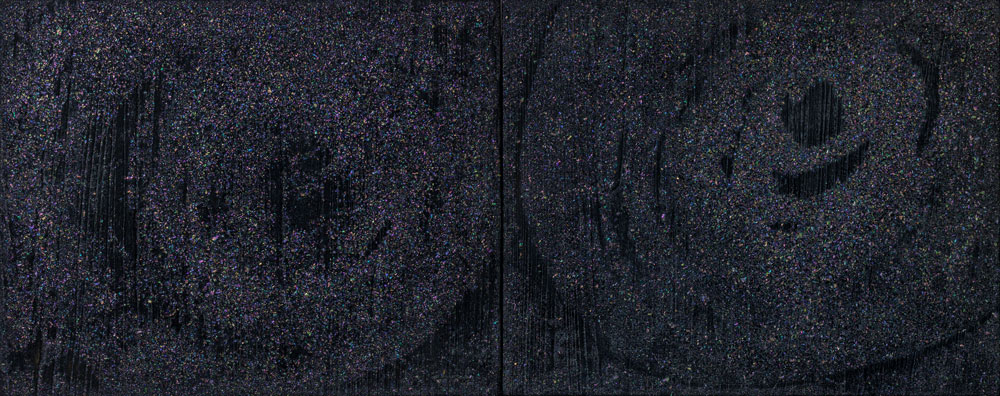
Work
73×183.5cm 자개,옻,목재 2023
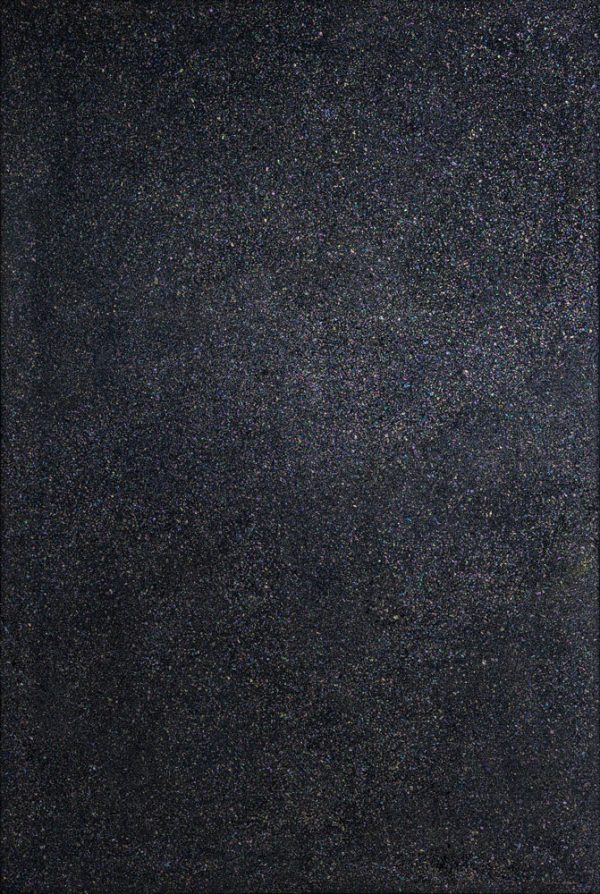
Work
193×130cm 자개,옻,캔버스 2023
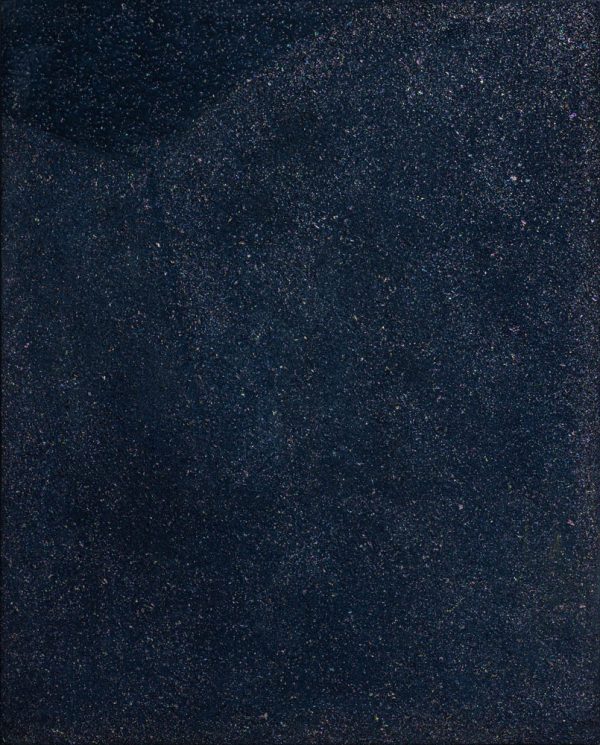
Work
162.2×130.3cm 자개,옻,캔버스 2023

Work
120.5×90.5cm 자개,옻,목재 2023
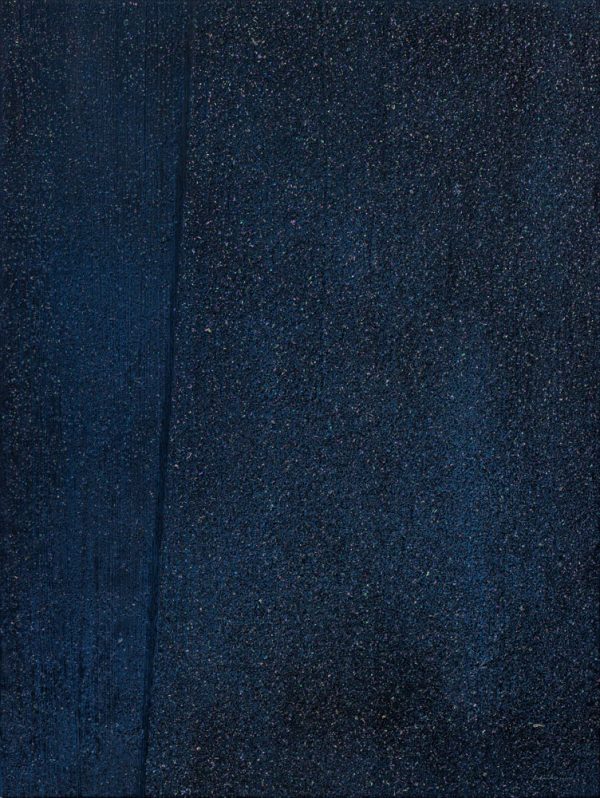
Work
120.5×90.5cm 자개,옻,목재 2023
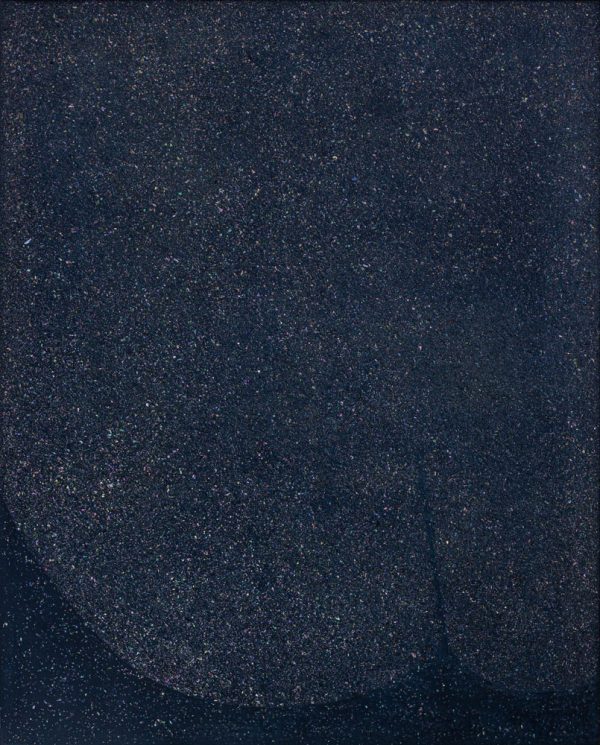
Work
162.2×130.3cm 자개,옻,캔버스 2023
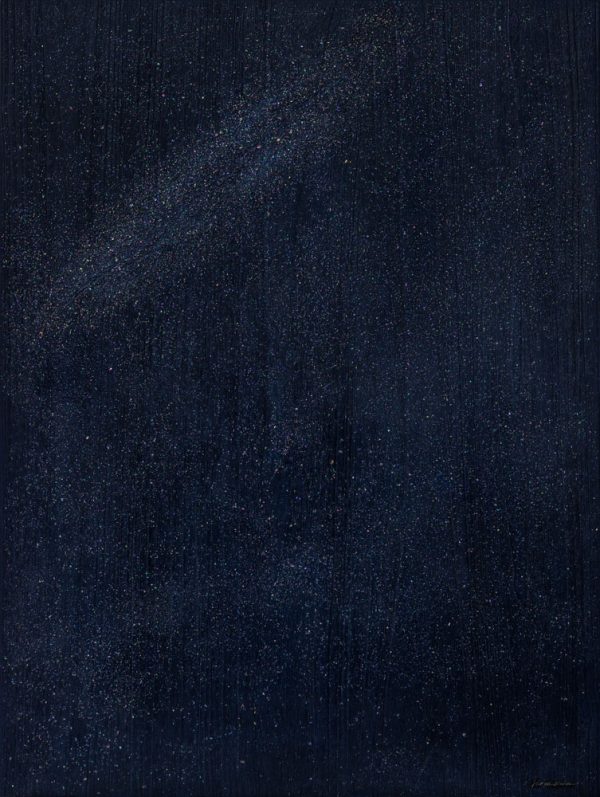
Work
120.5×90.5cm 자개,옻,목재 2023
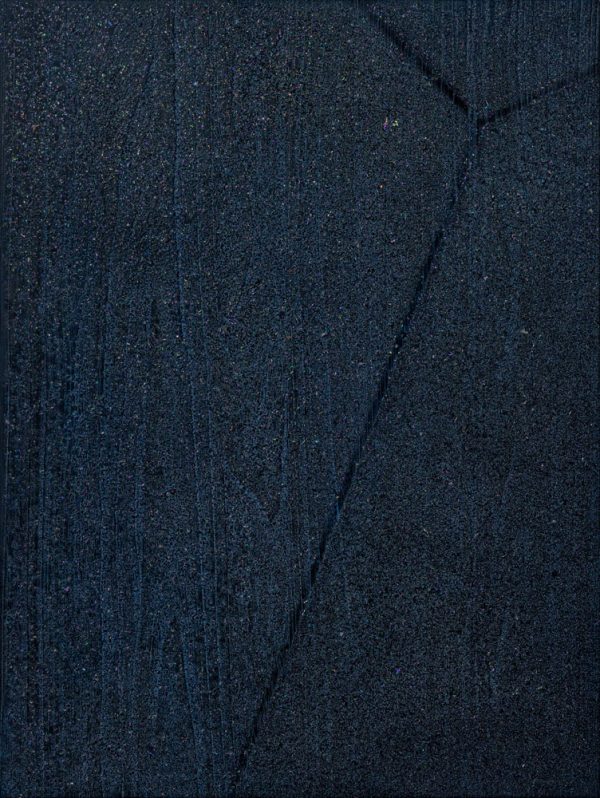
Work
120.5×90.5cm 자개,옻,목재 2023
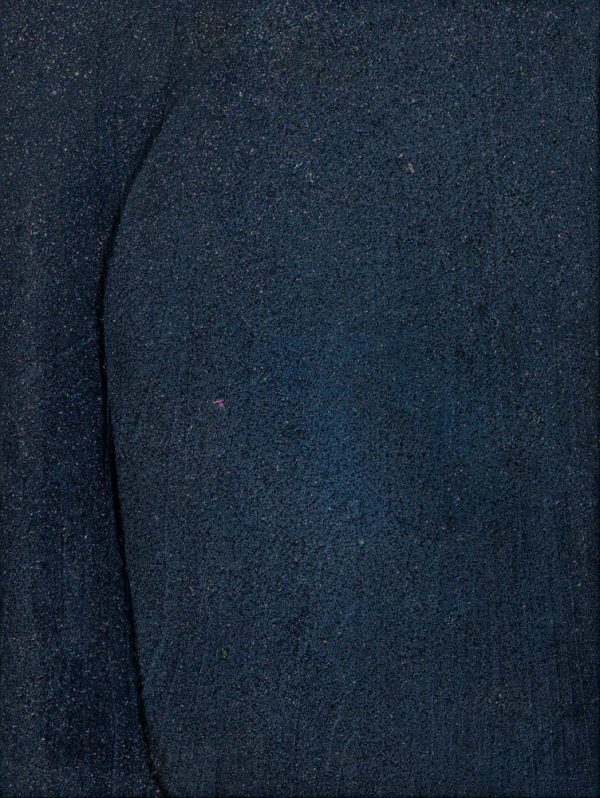
Work
120.5×90.5cm 자개,옻,목재 2023
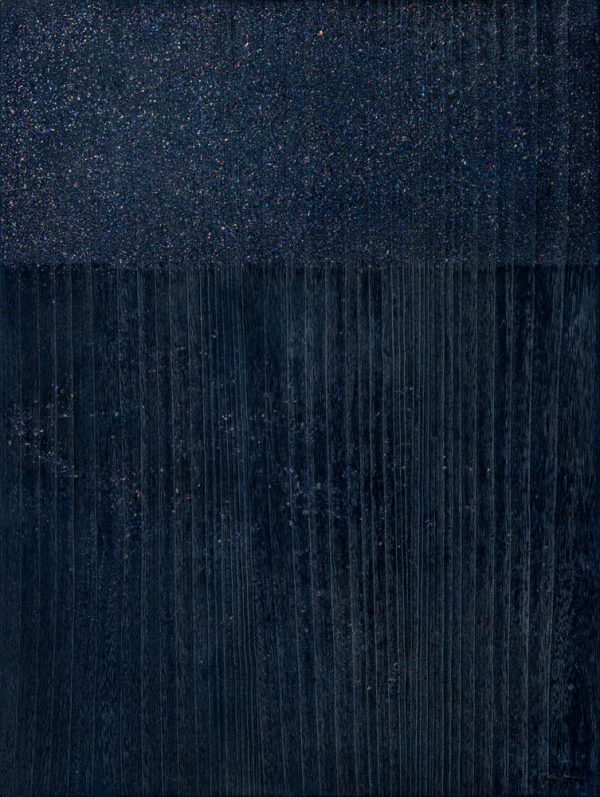
Work
120.5×90.5cm 자개,옻,목재 2023
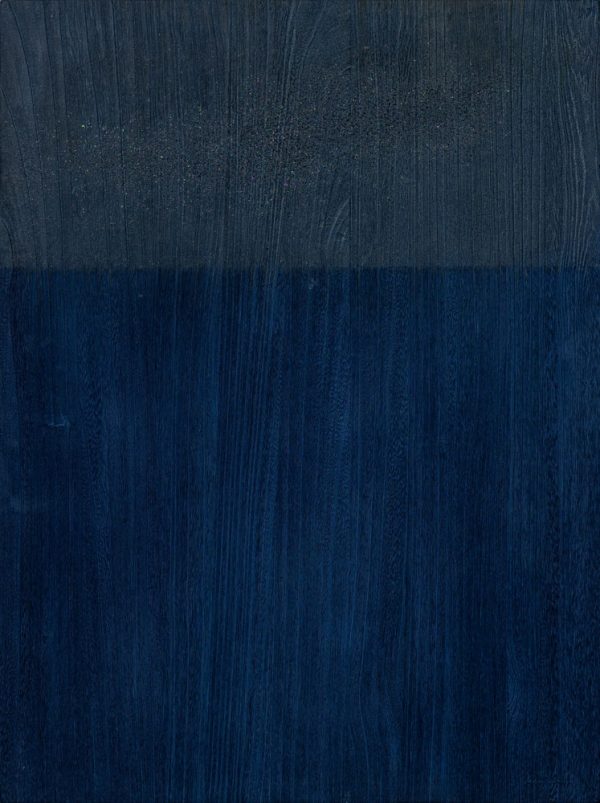
Work
120.5×90.5cm 자개,옻,목재 2023
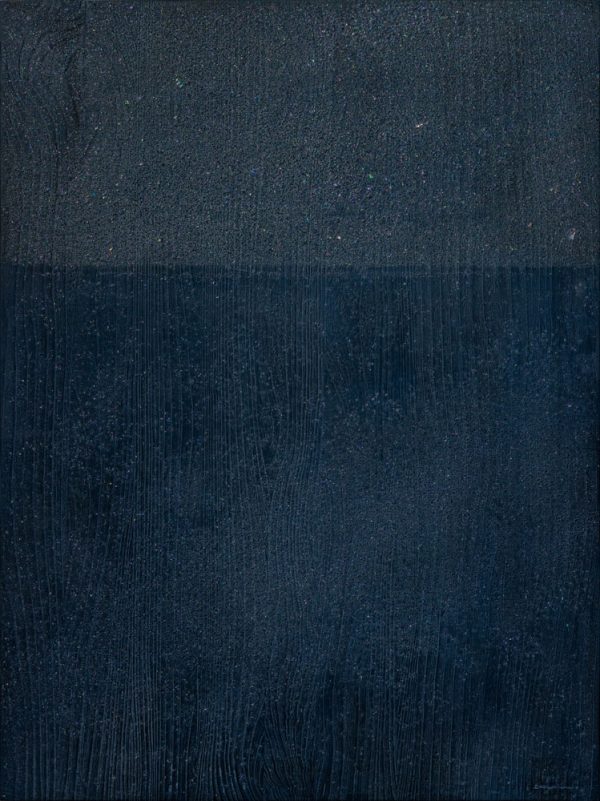
Work
120.5×90.5cm 자개,옻,목재 2023
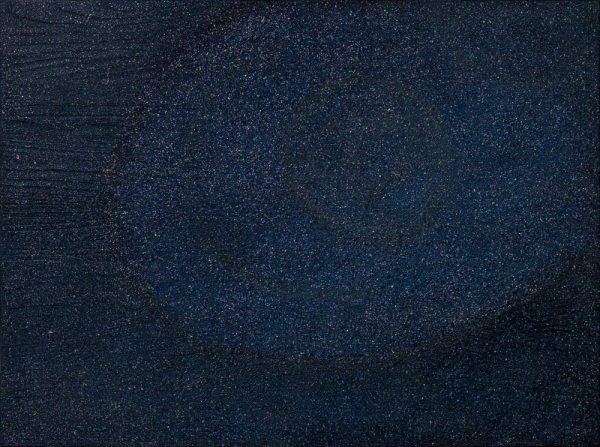
Work
90.5×120.5cm 자개,옻,목재 2023
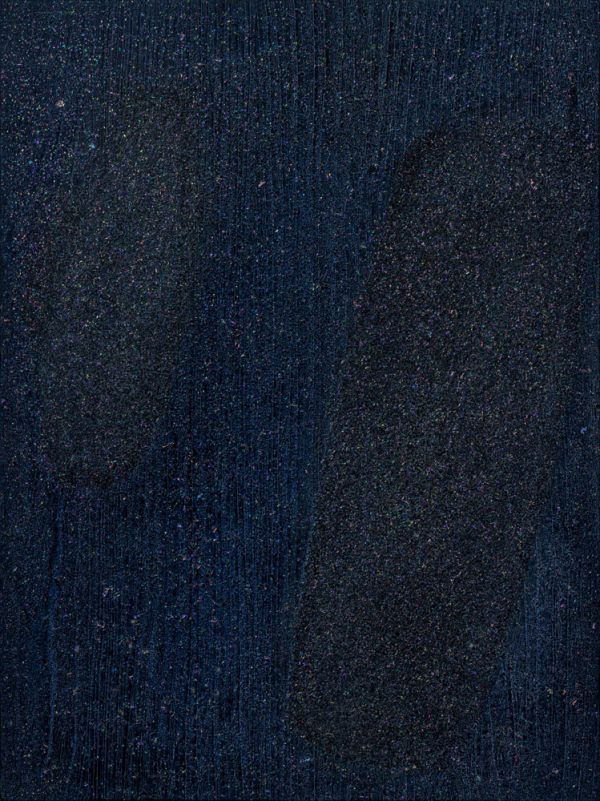
Work
120.5×90.5cm 자개,옻,목재 2023
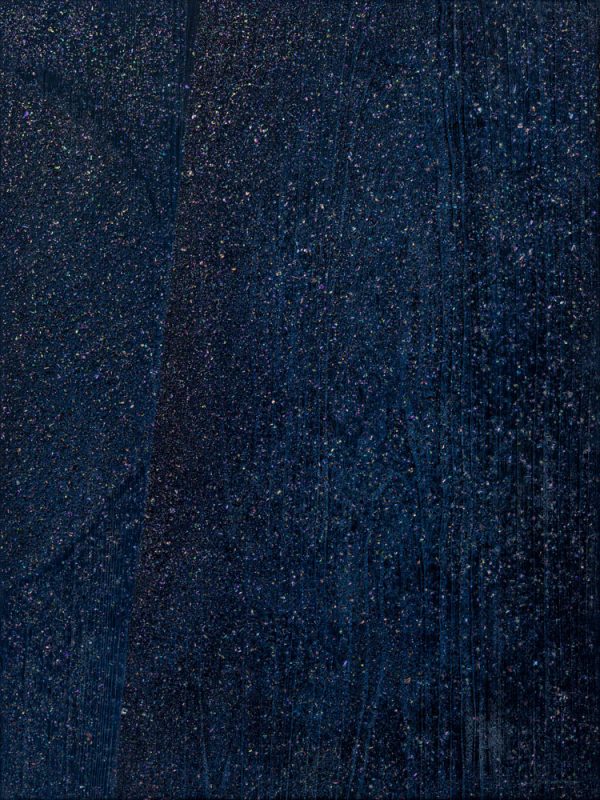
Work
120.5×90.5cm 자개,옻,목재 2023
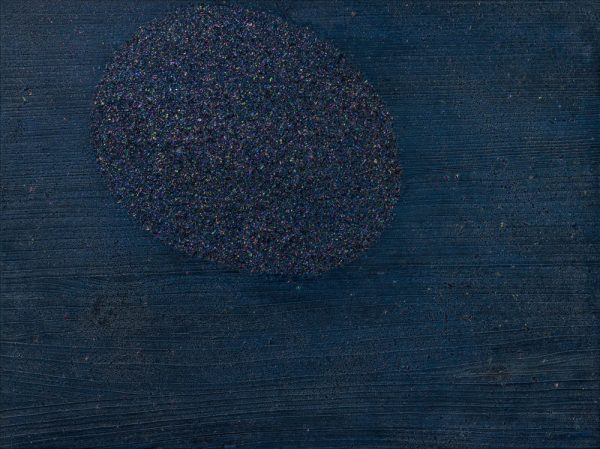
Work
90.5×120.5cm 자개,옻,목재 2023

Work
120.5×90.5cm 자개,옻,목재 2023
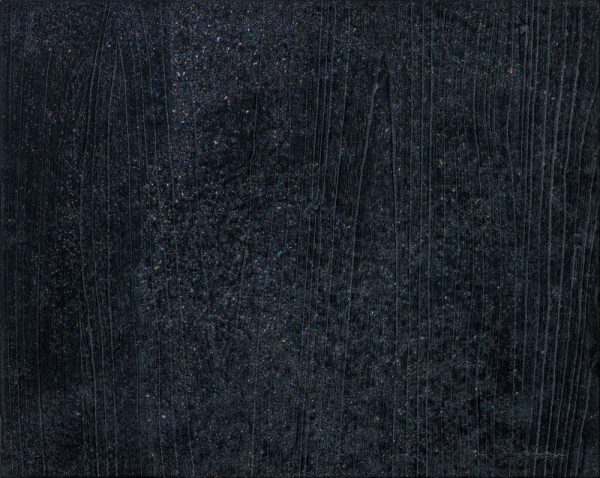
Work
73×91.5cm 자개,옻,목재 2023
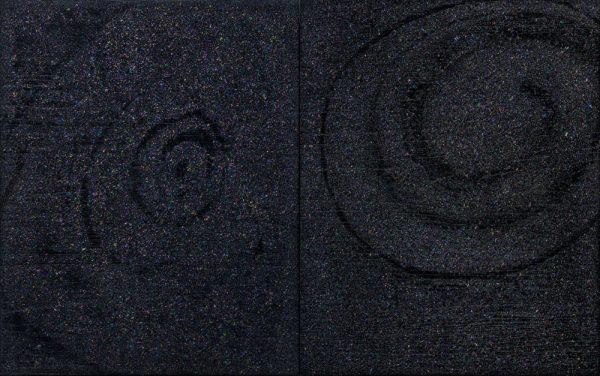
Work
90.5×146cm 자개,옻,목재 2023
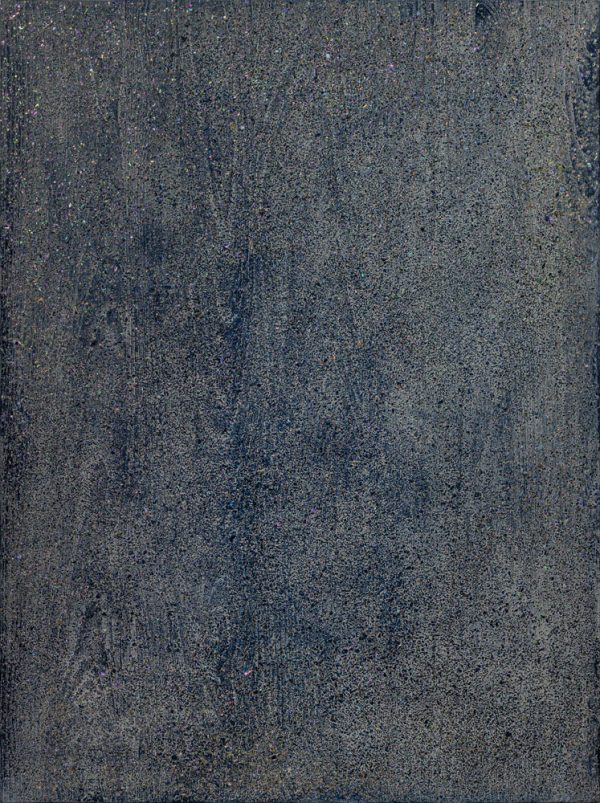
Work
120.5×90.5cm 자개,옻,목재 2023
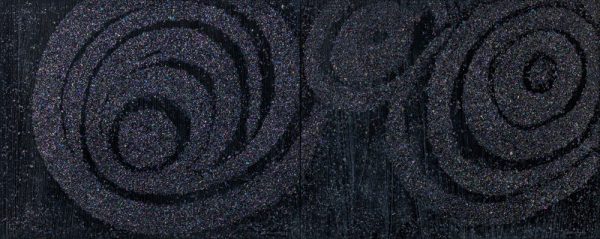
Work
91.5×146cm 자개,옻,목재 2023
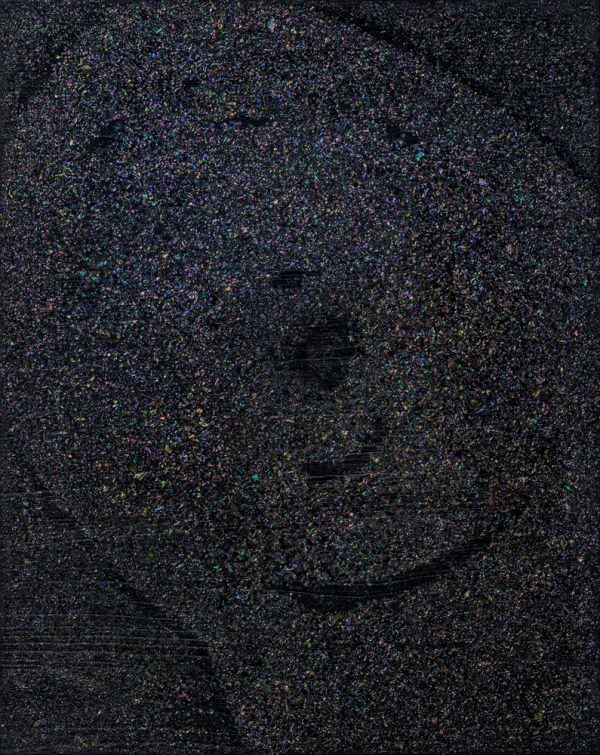
Work
90.5×73cm 자개,옻,목재 2023
Artist
김 선 갑 | Sun Kab, Kim
작품 구입 문의
Contact For Price

